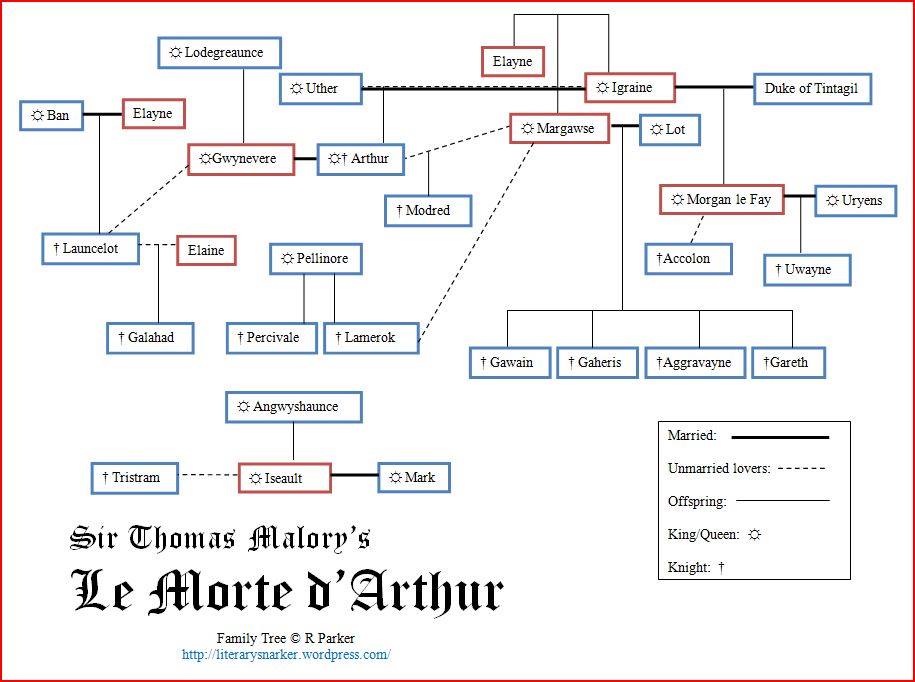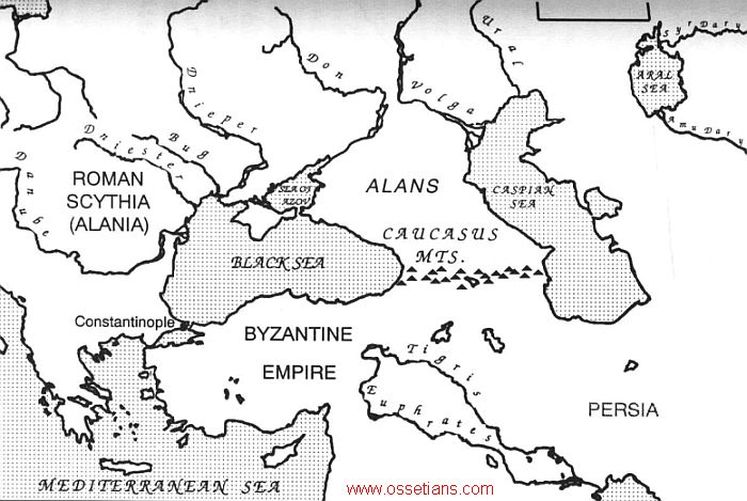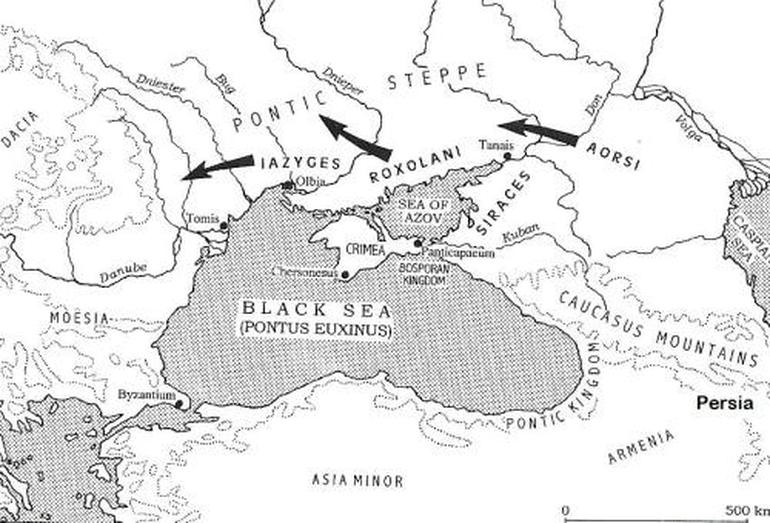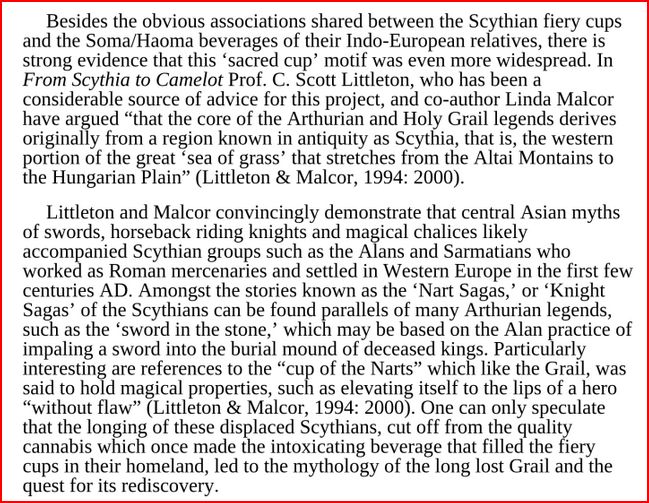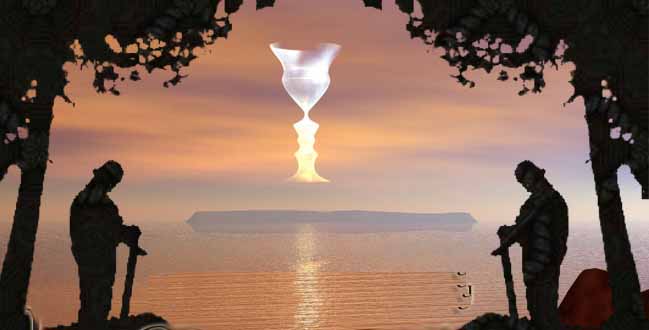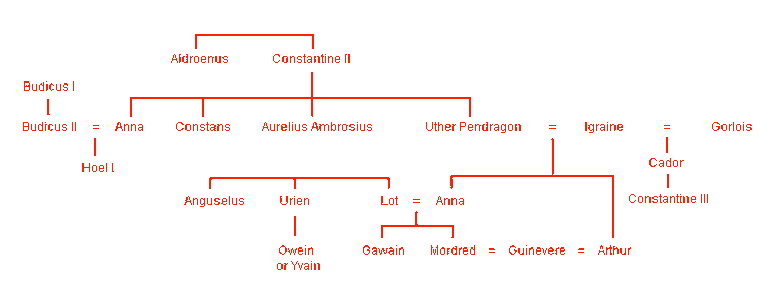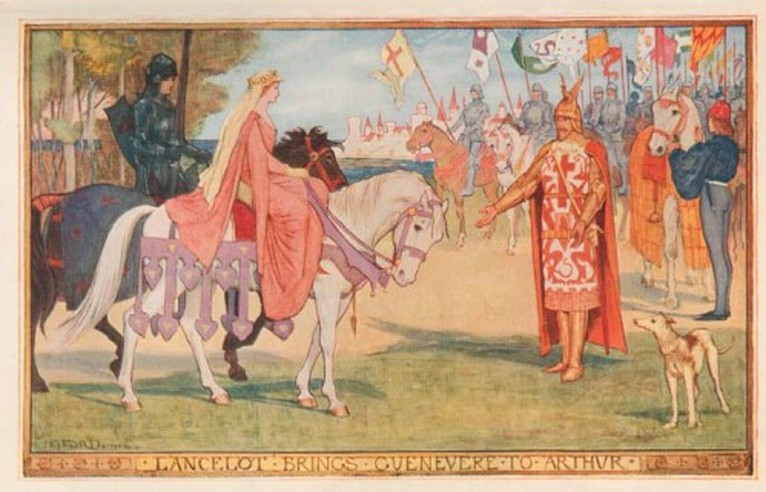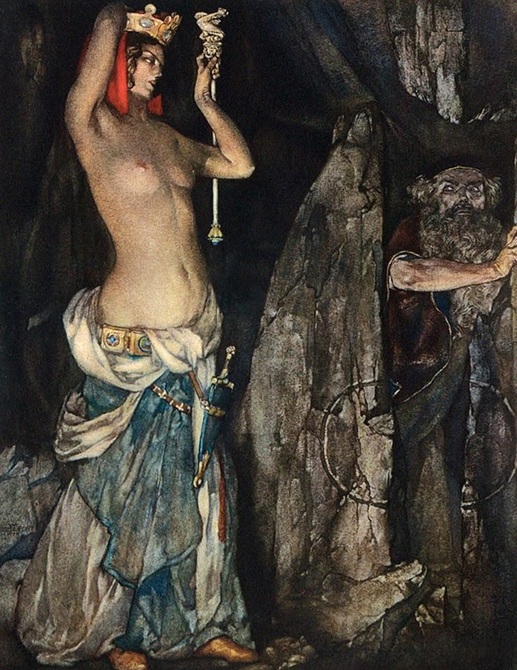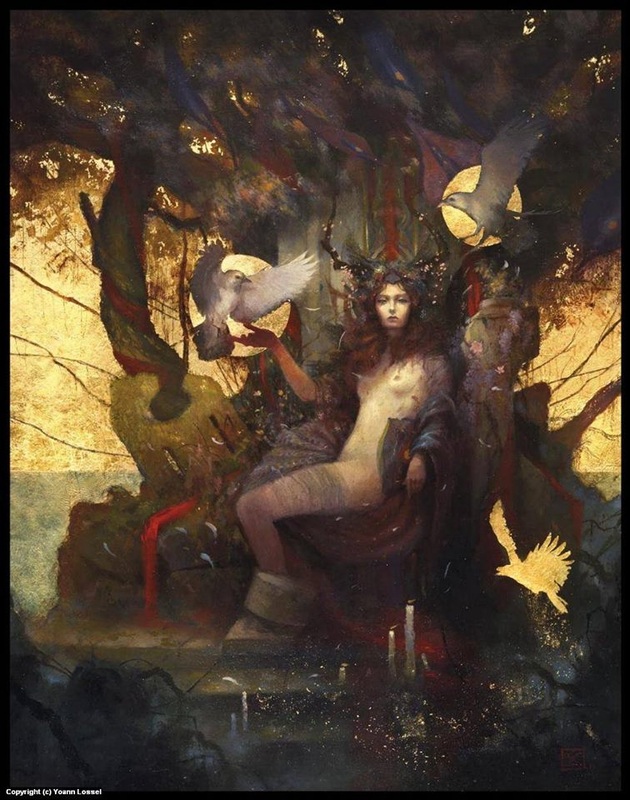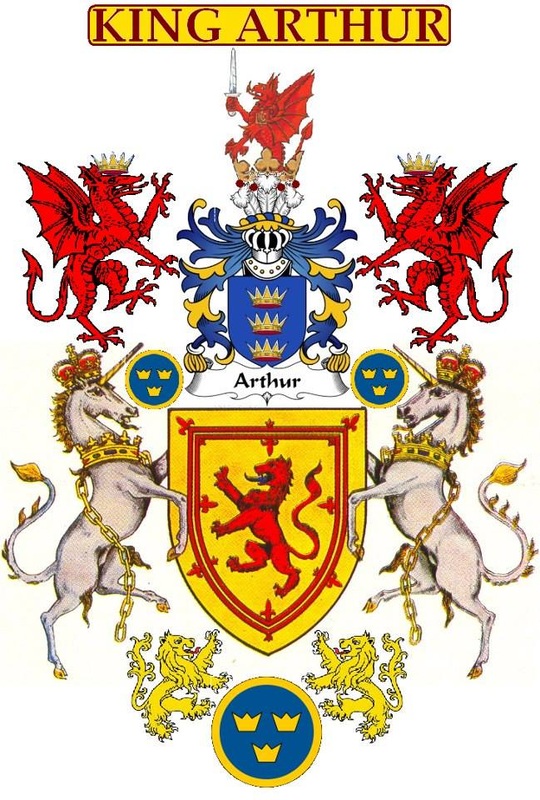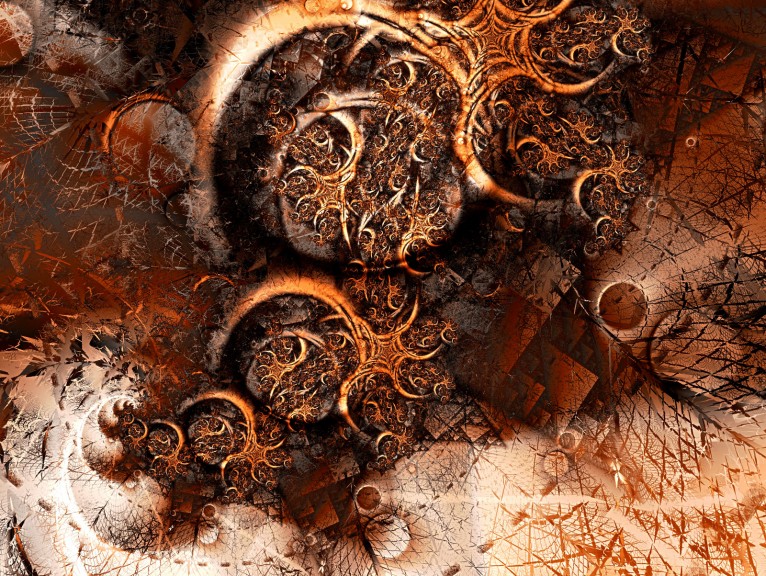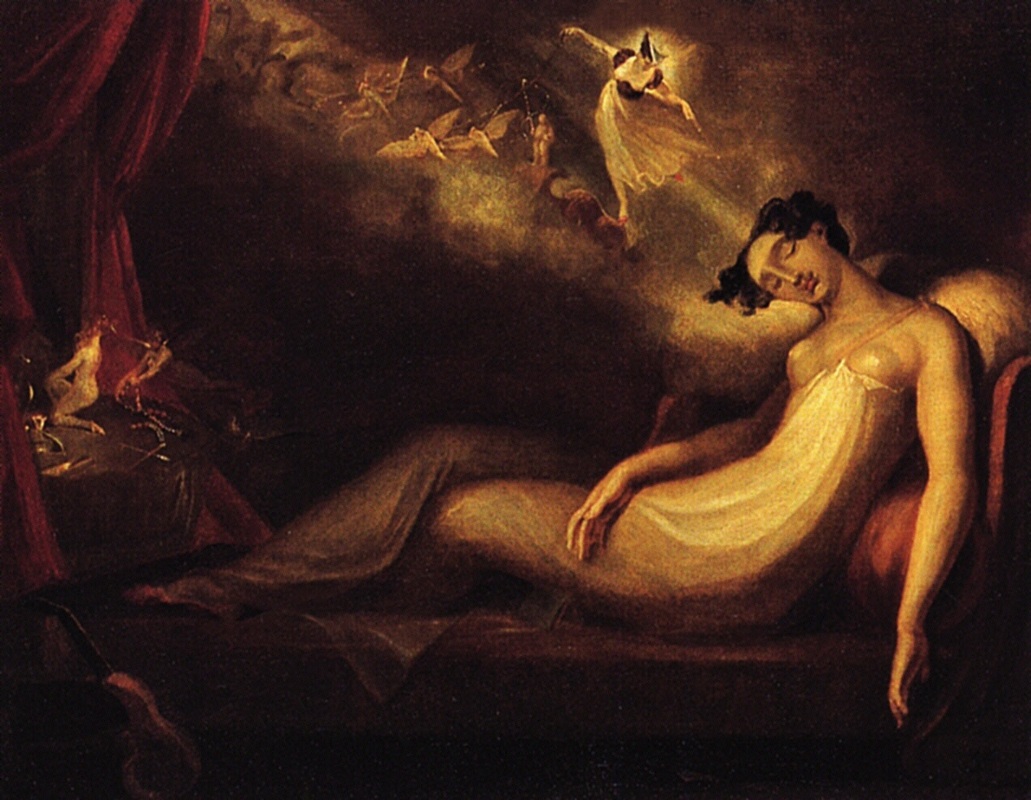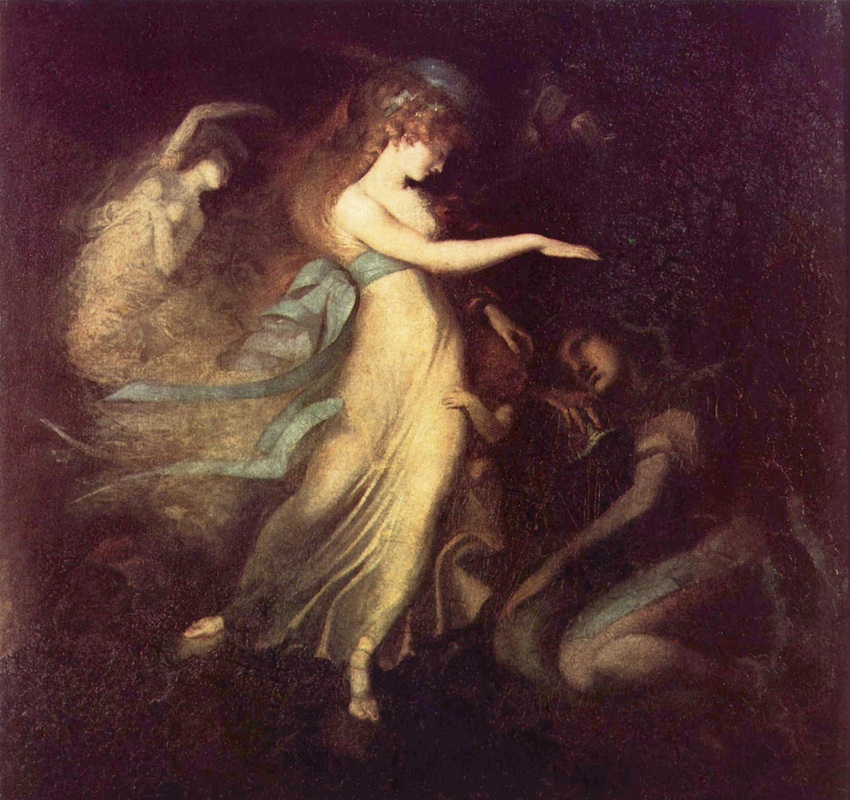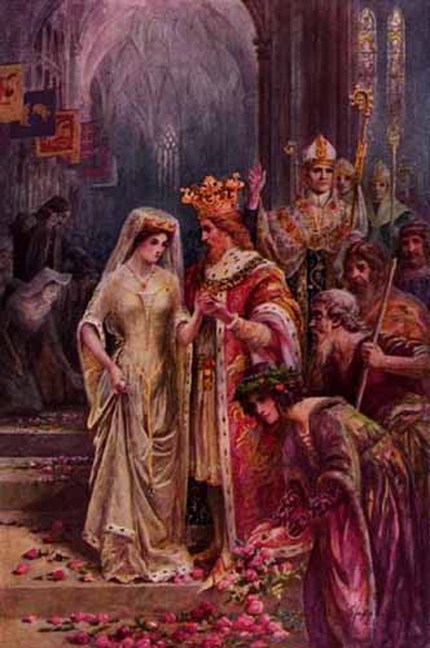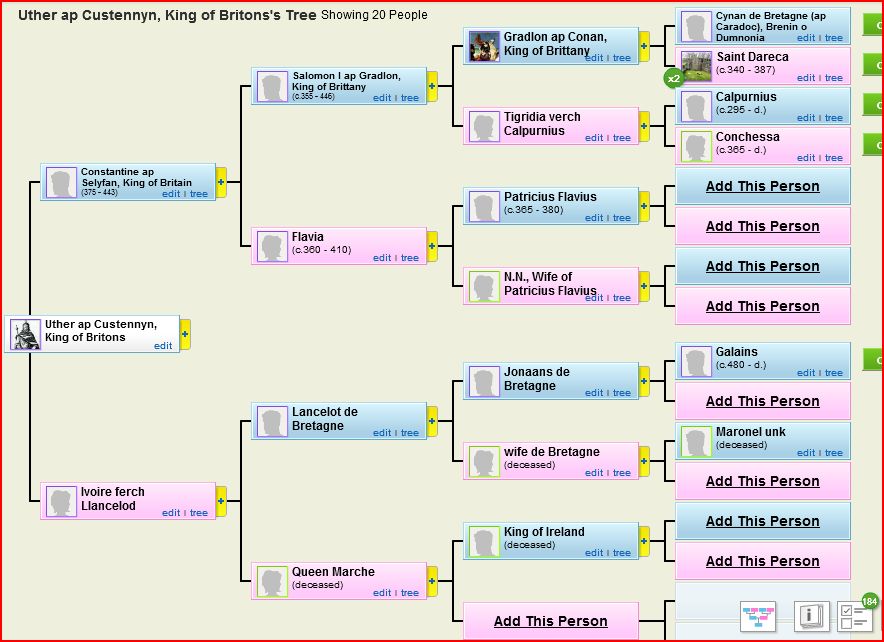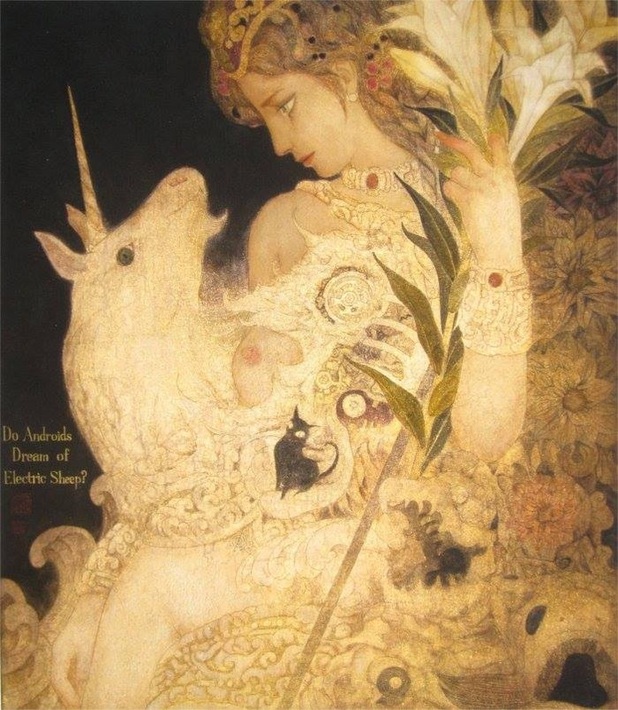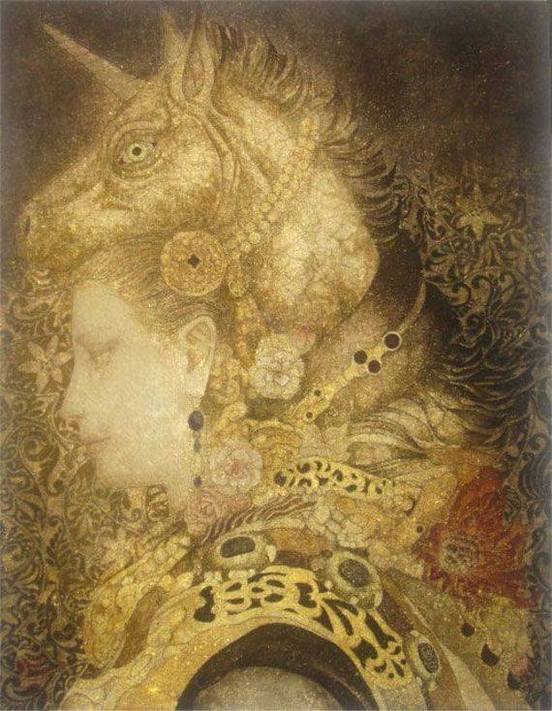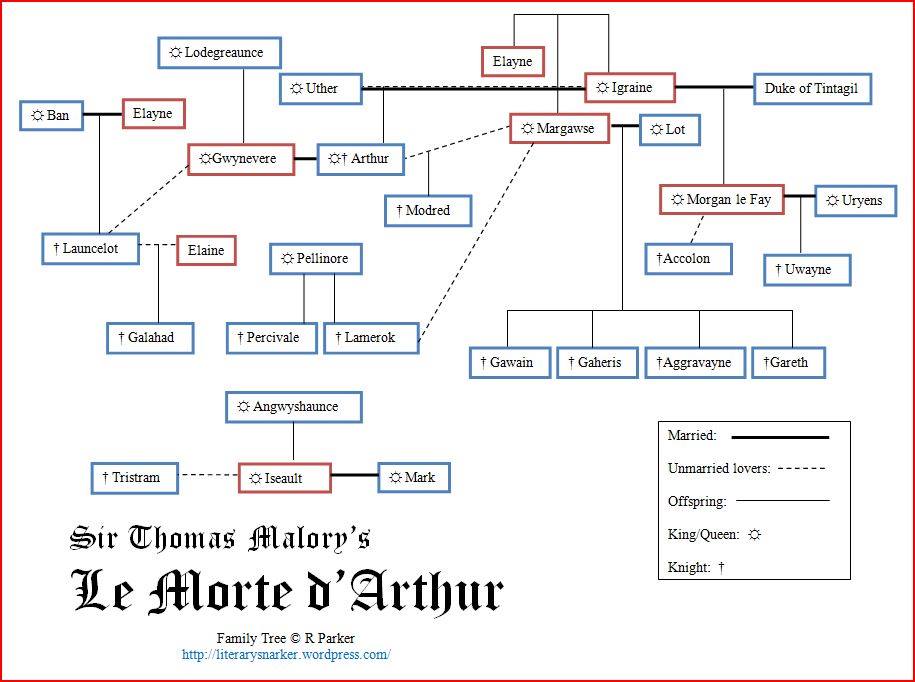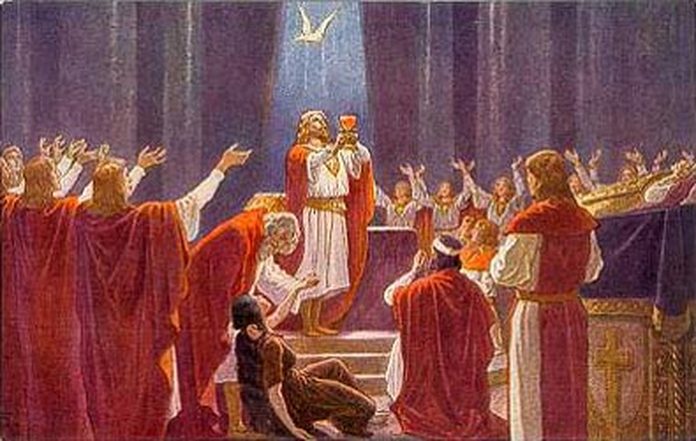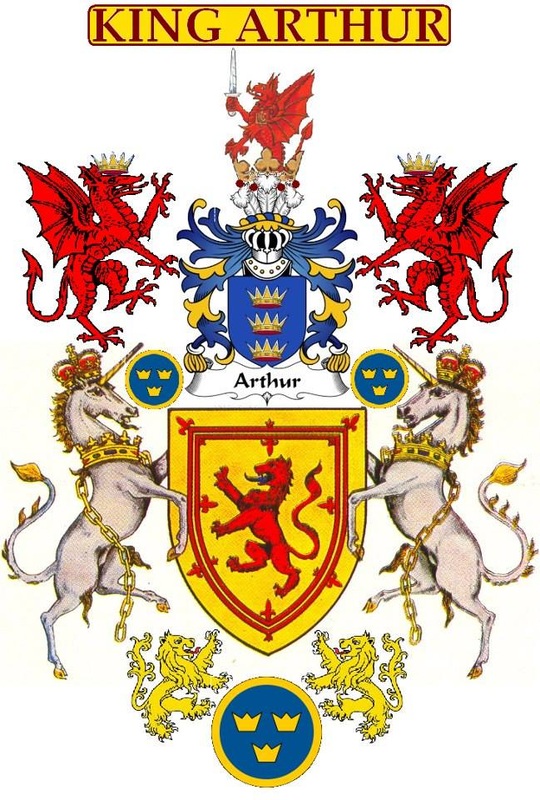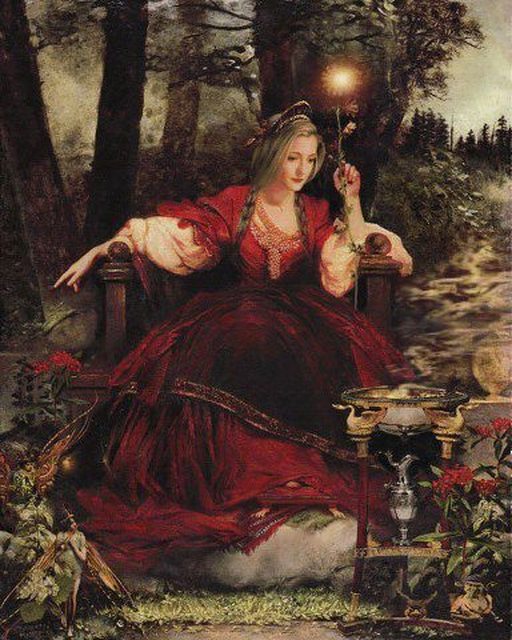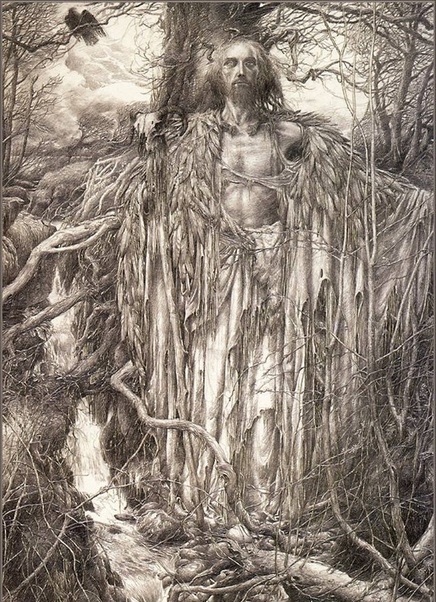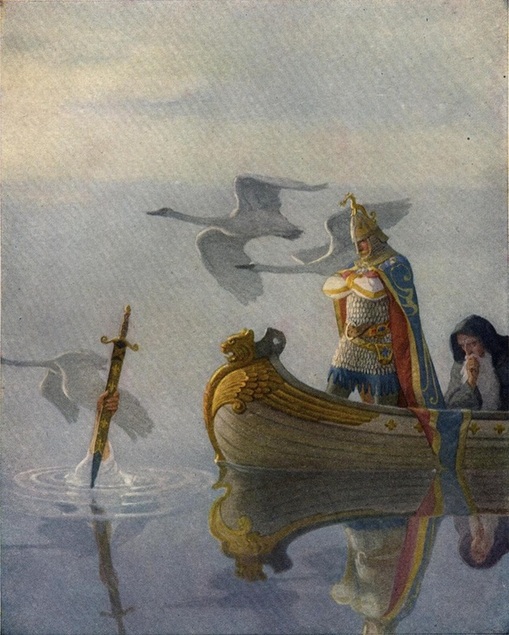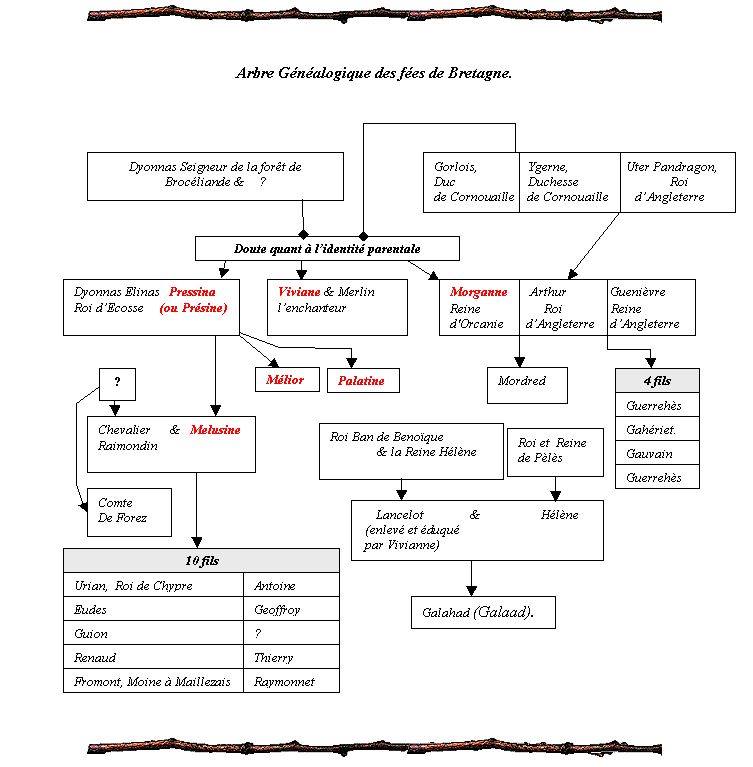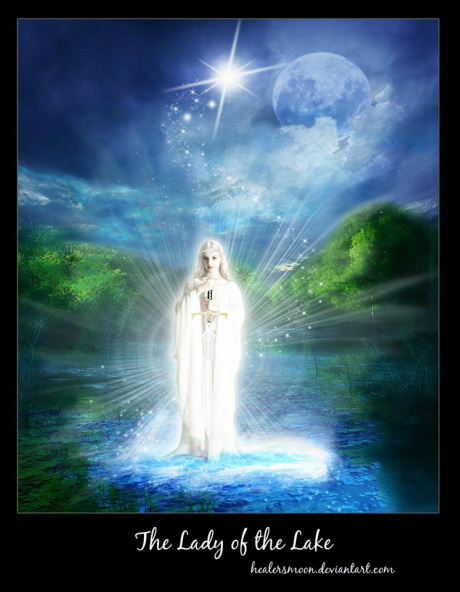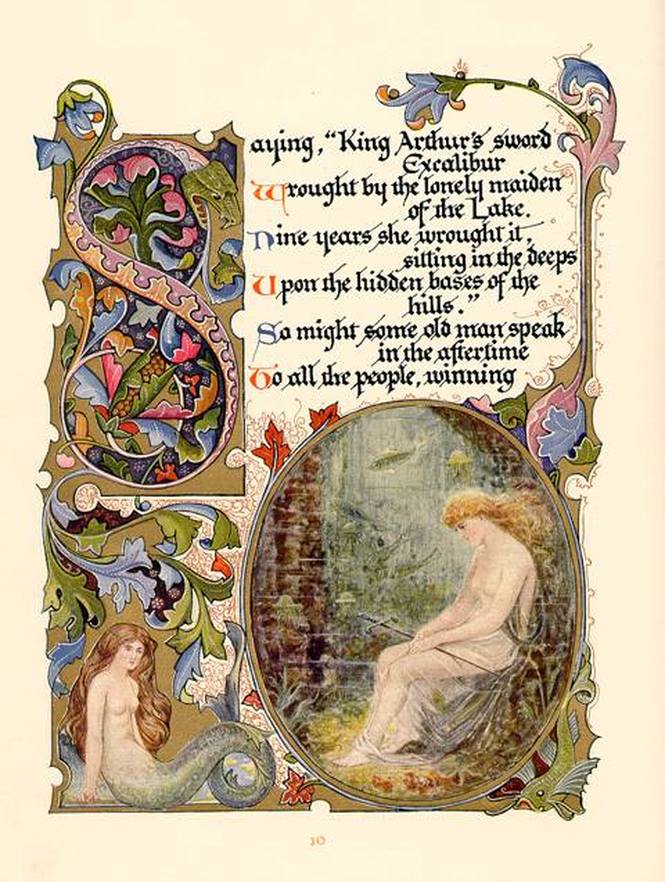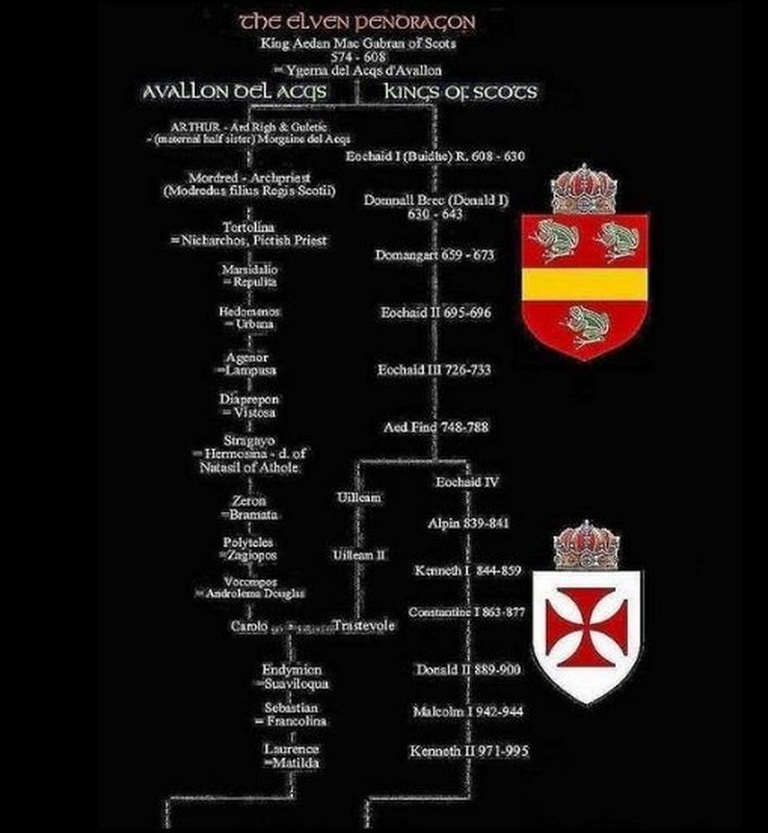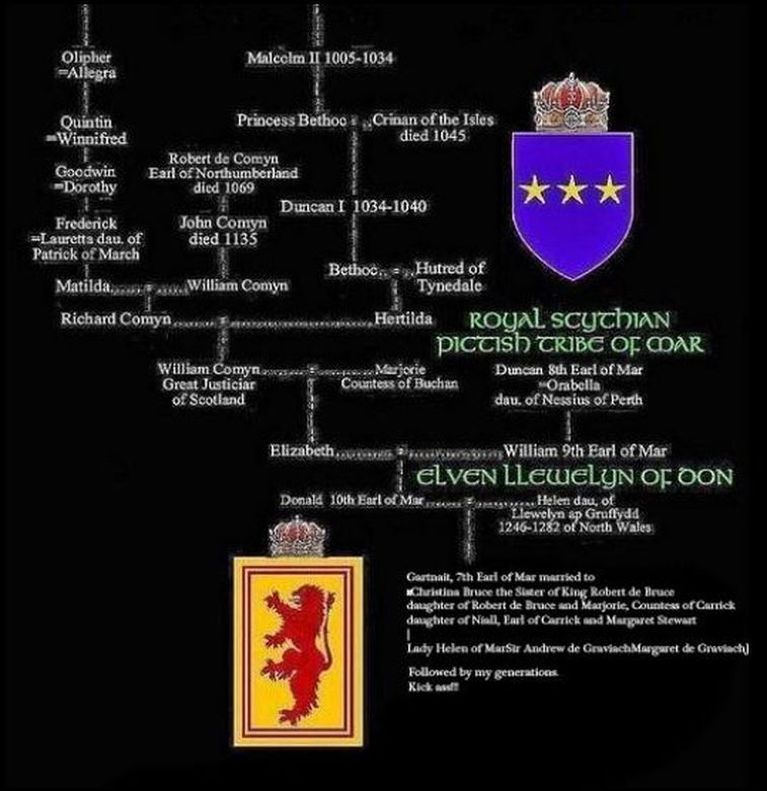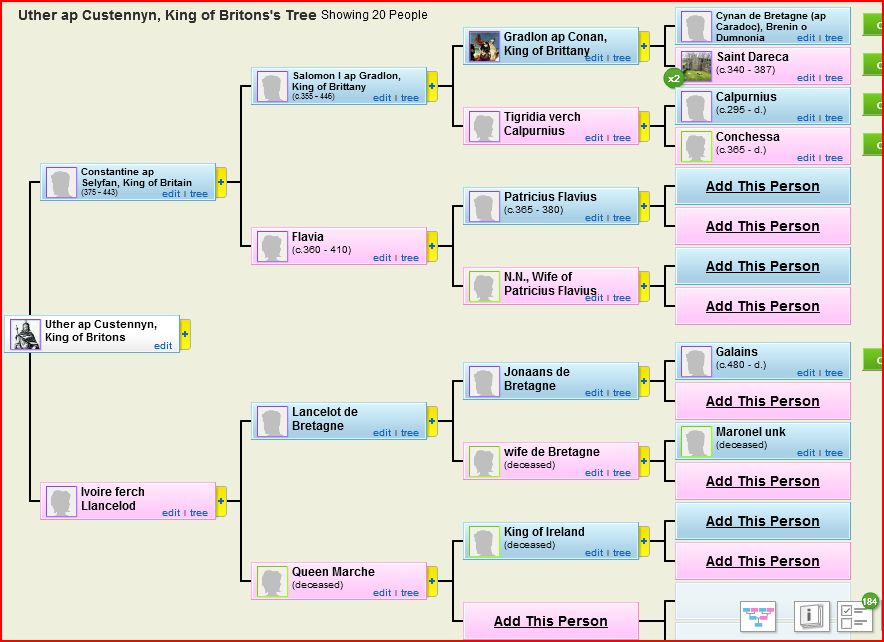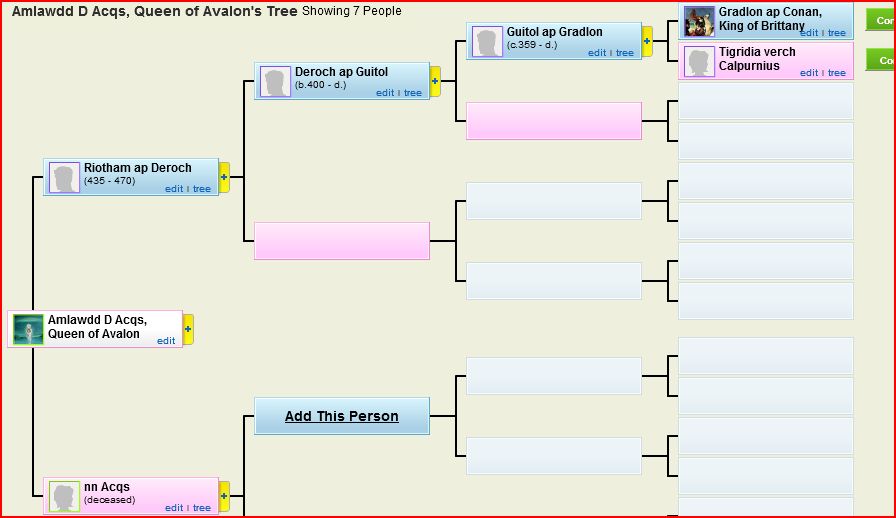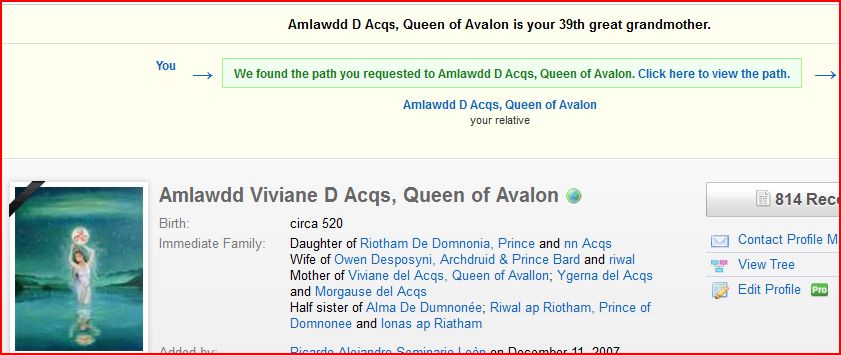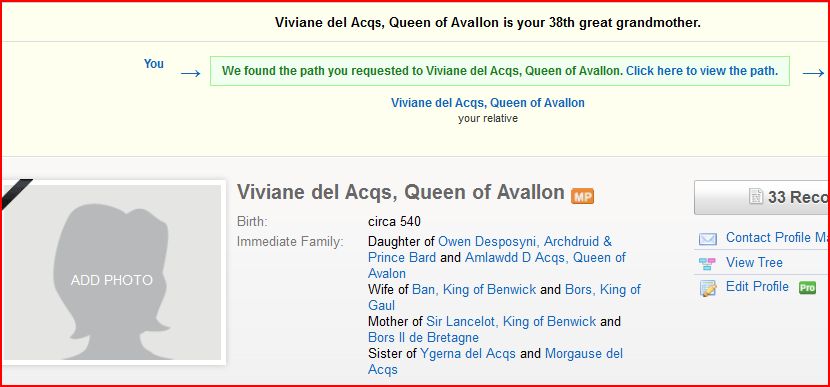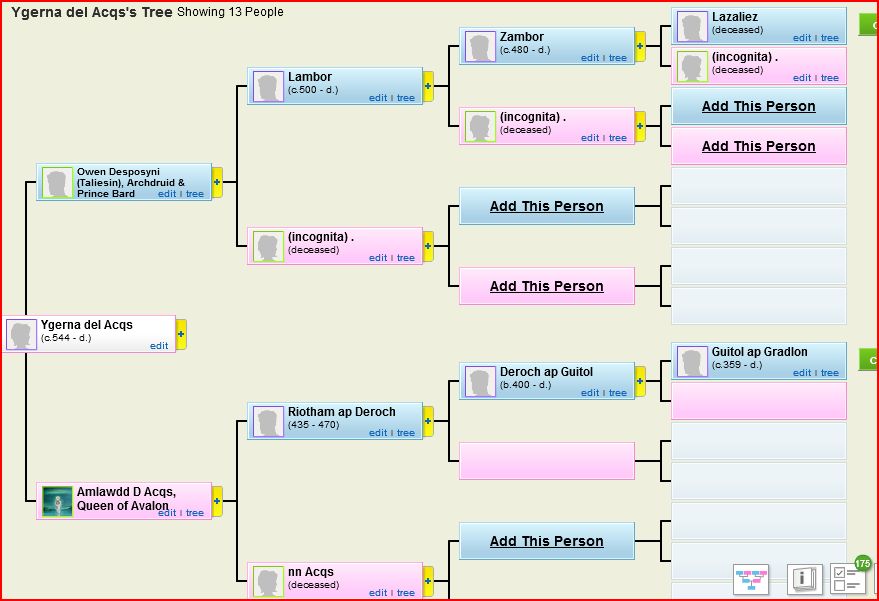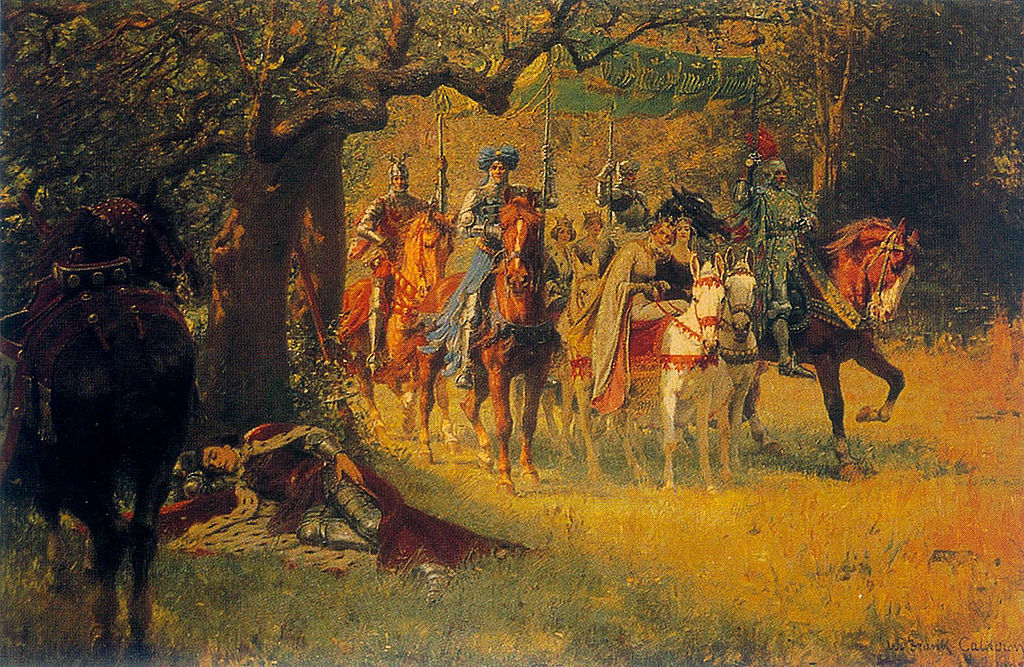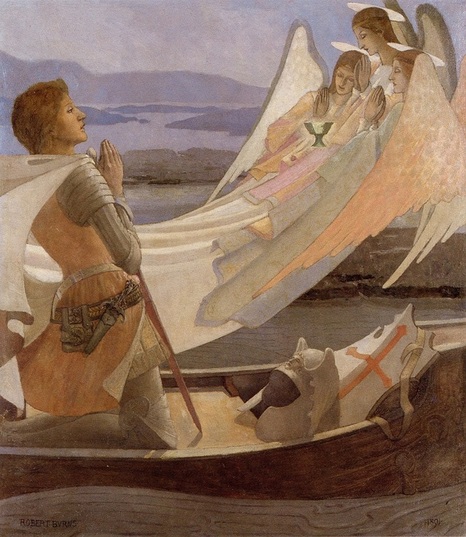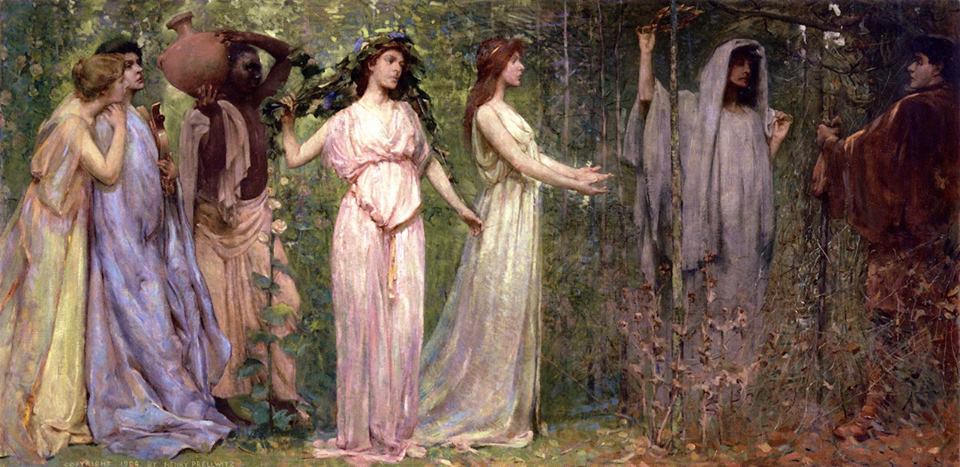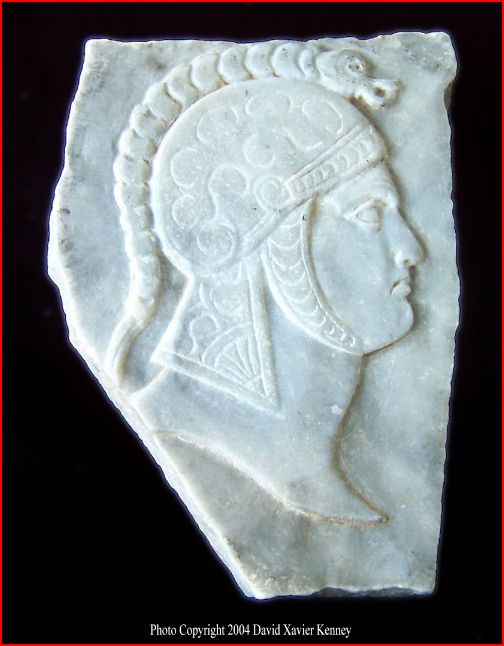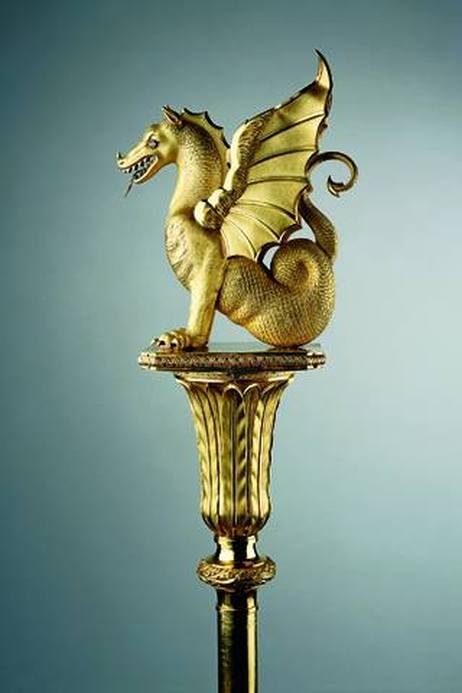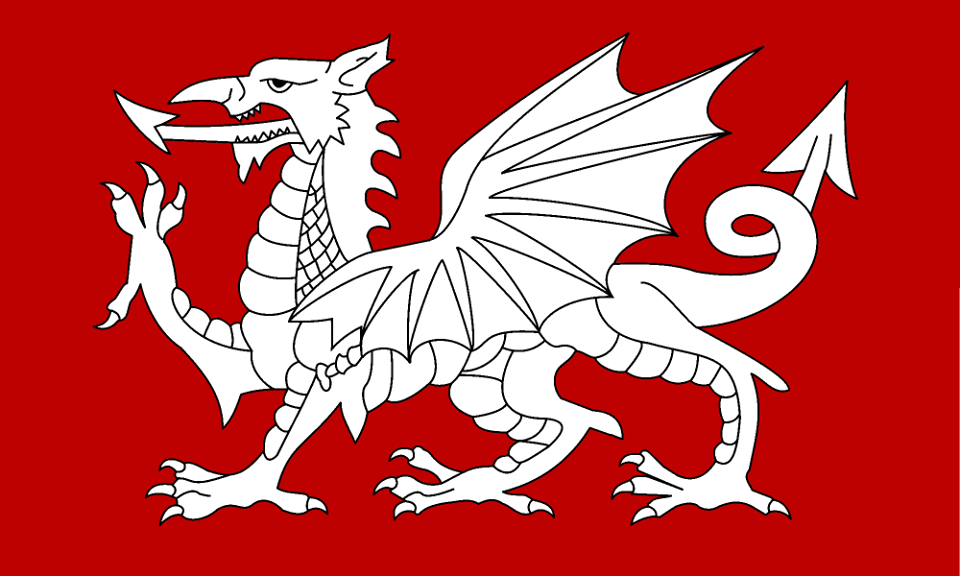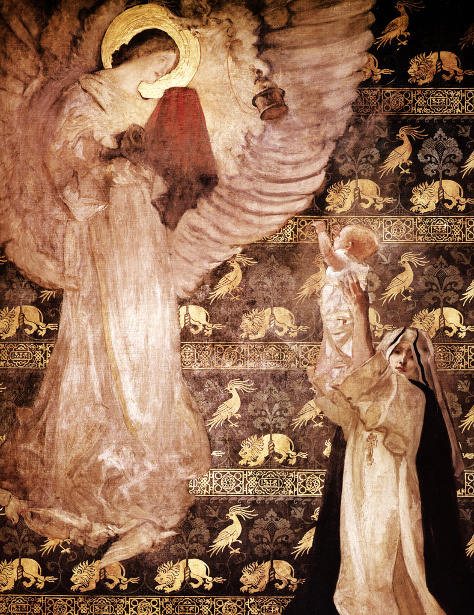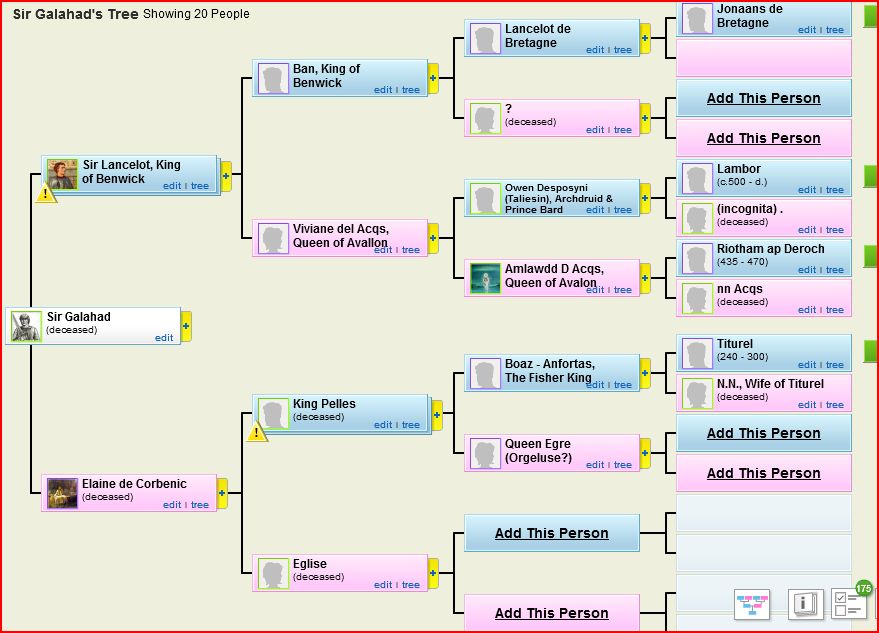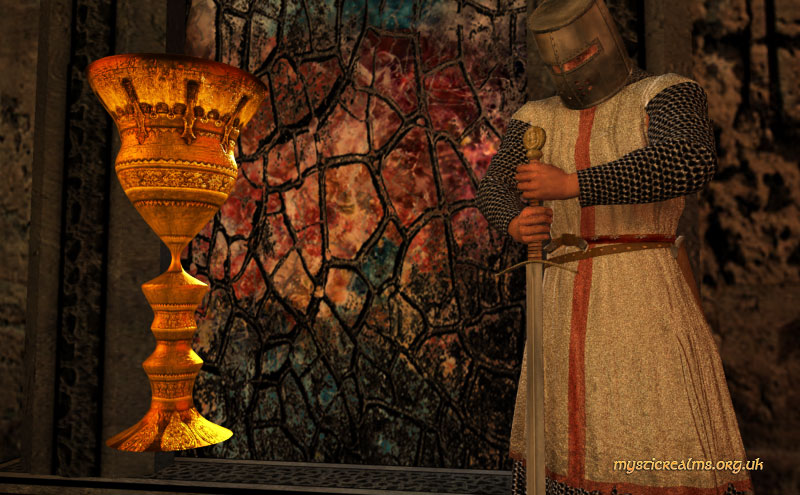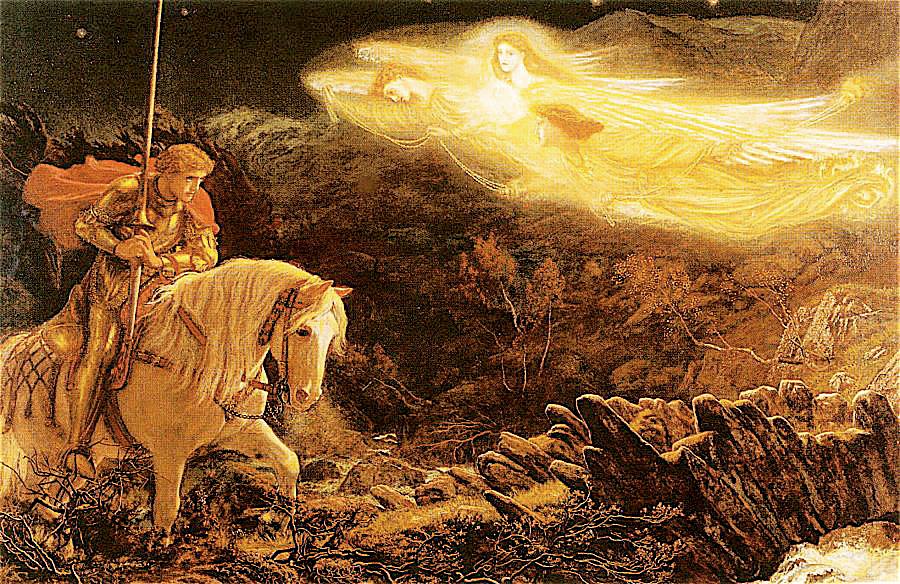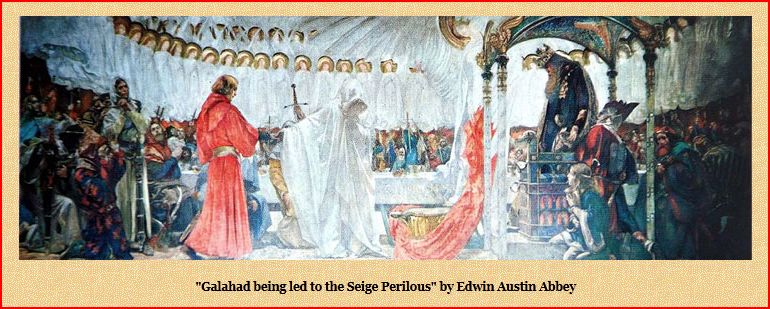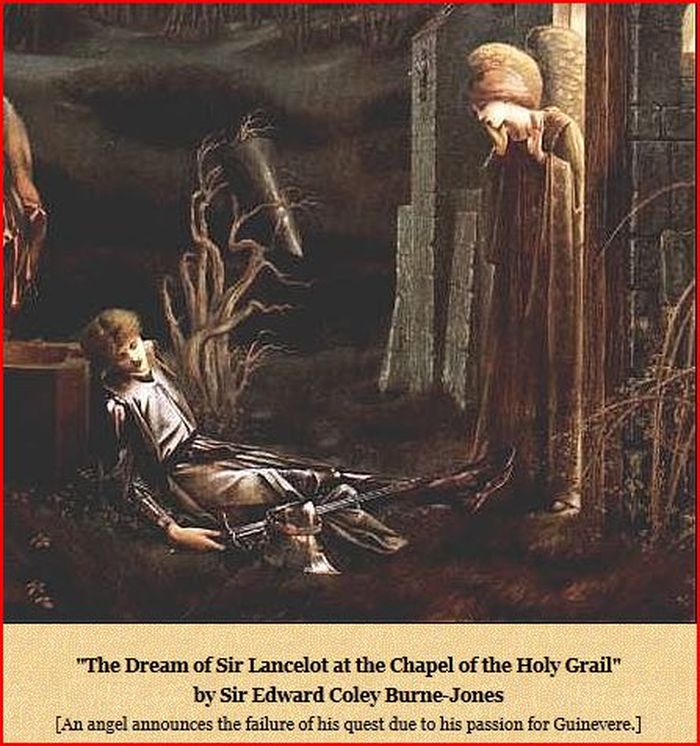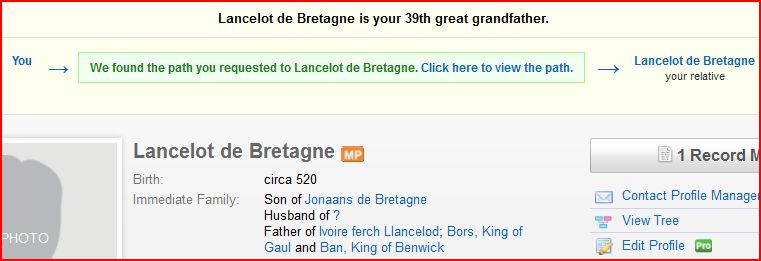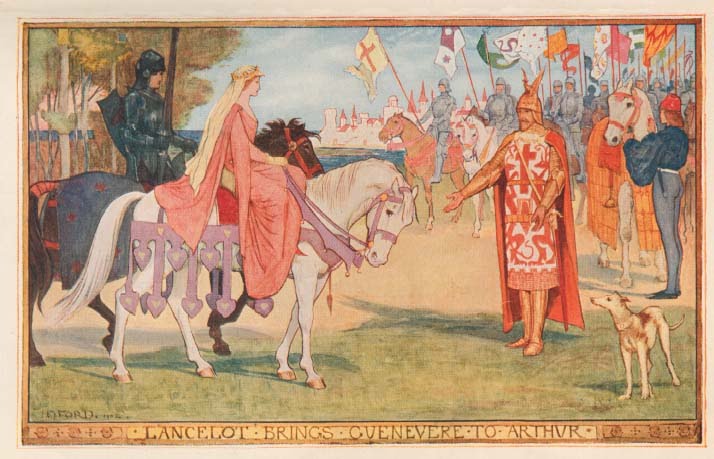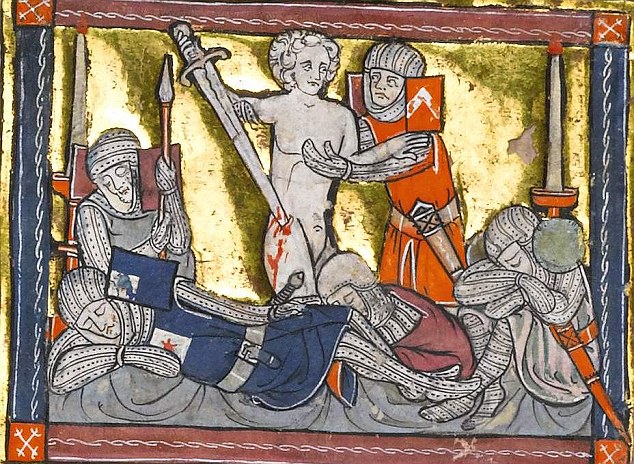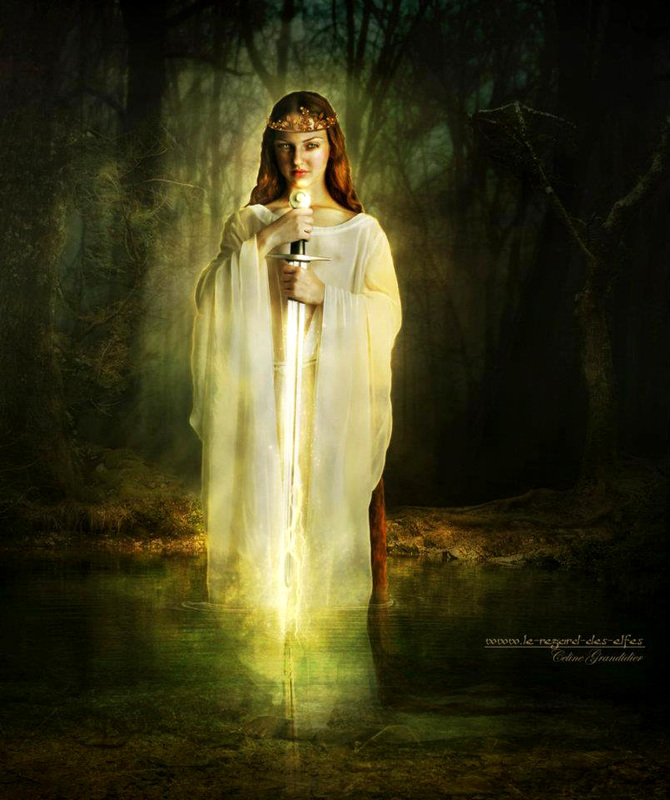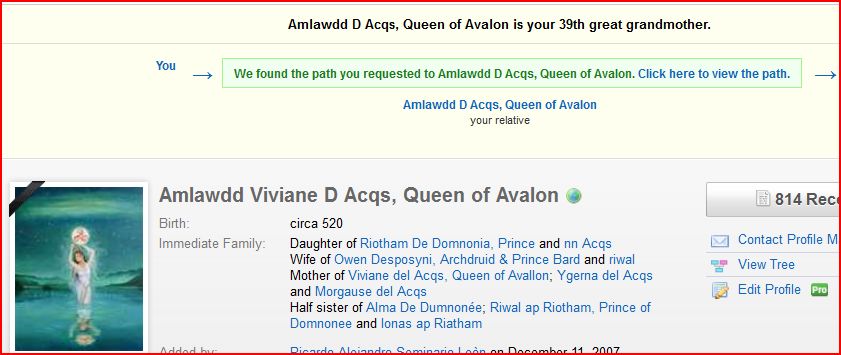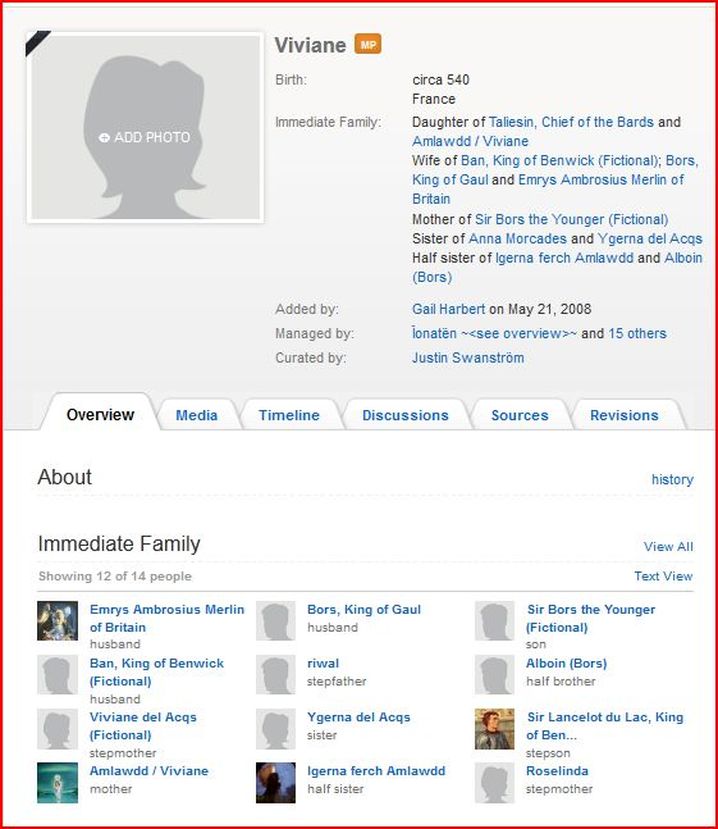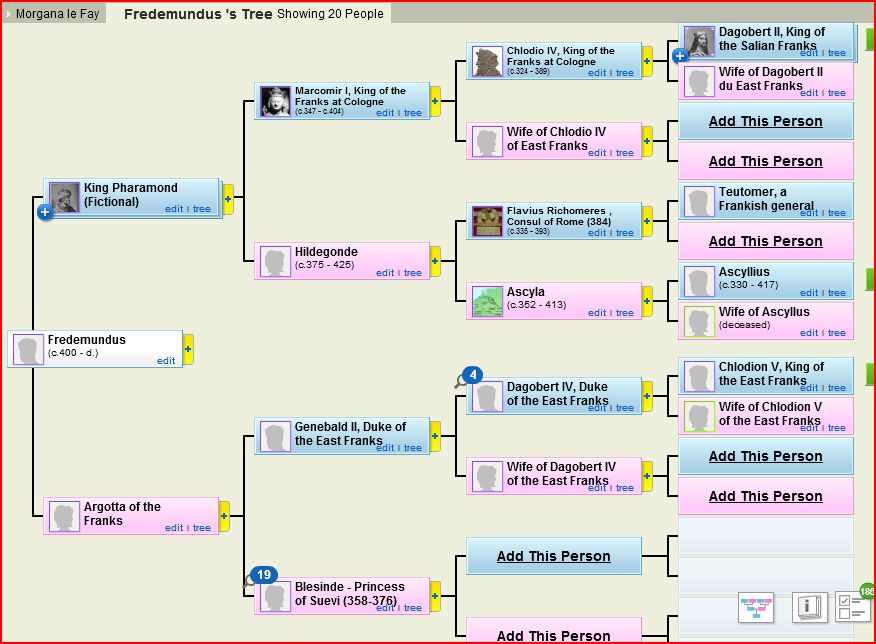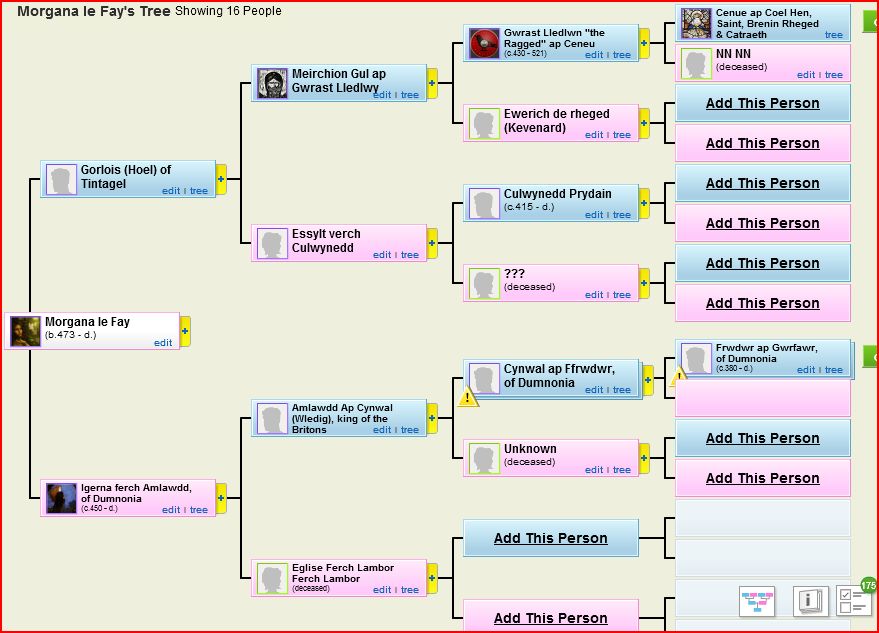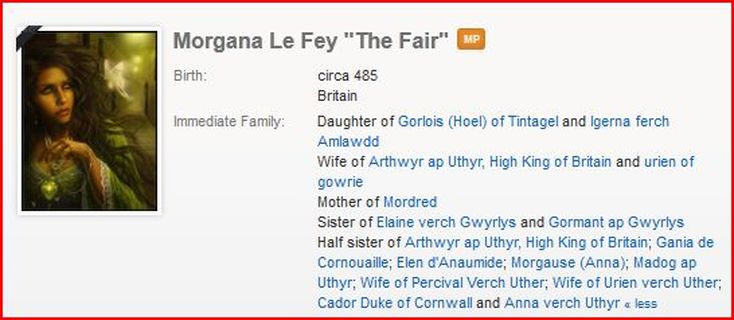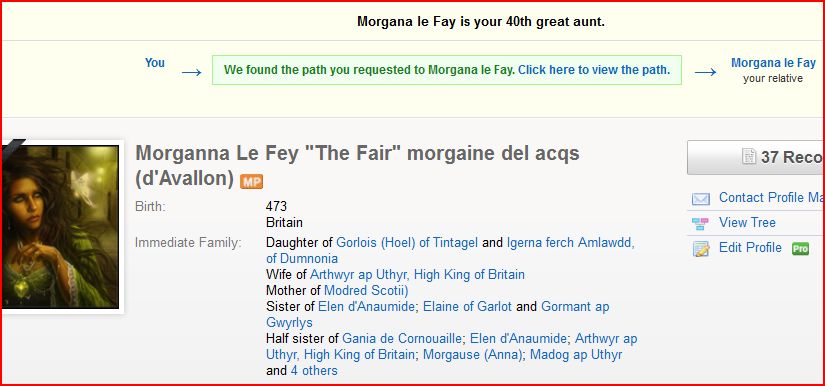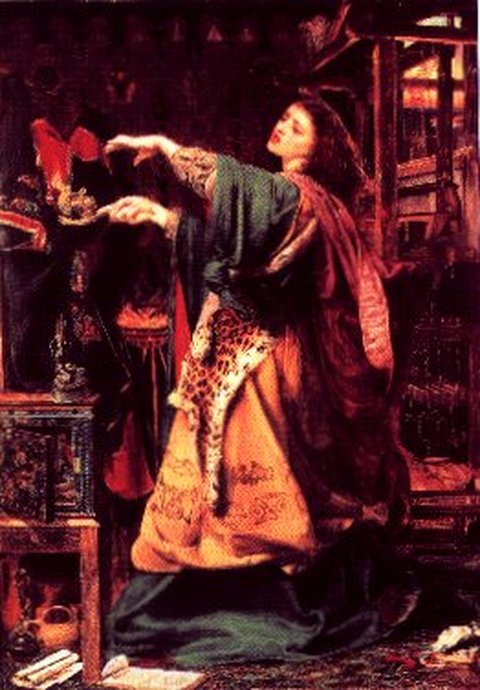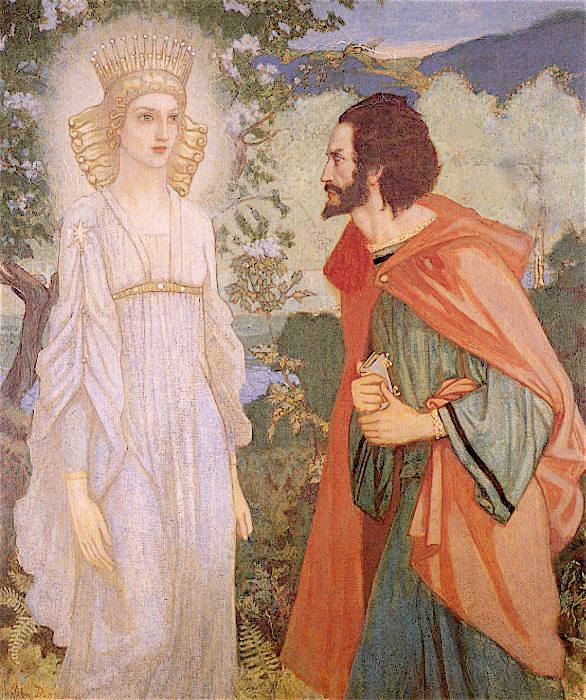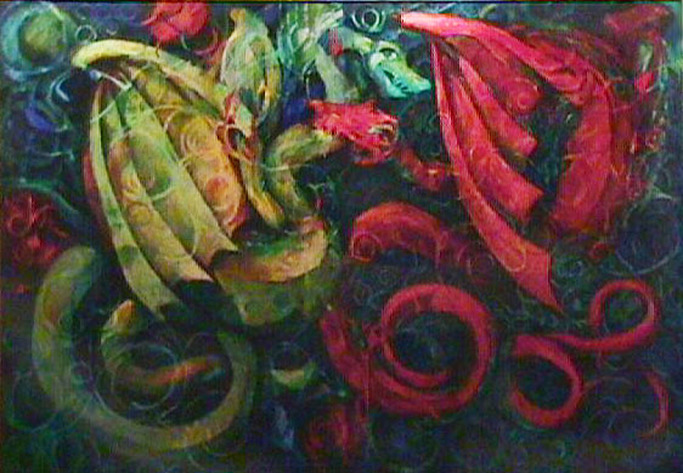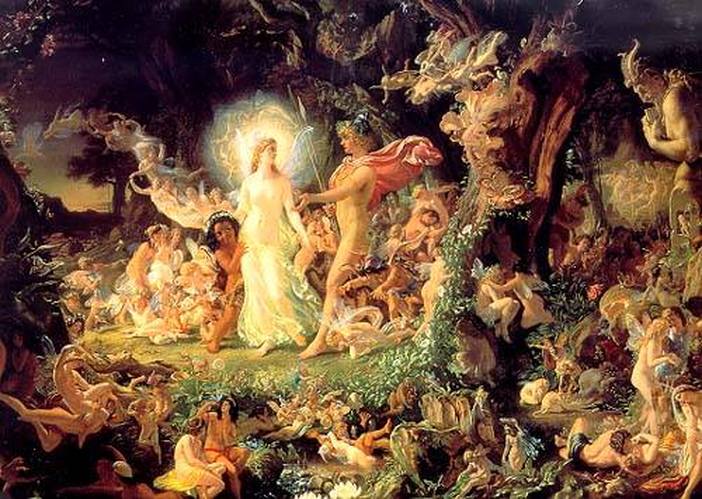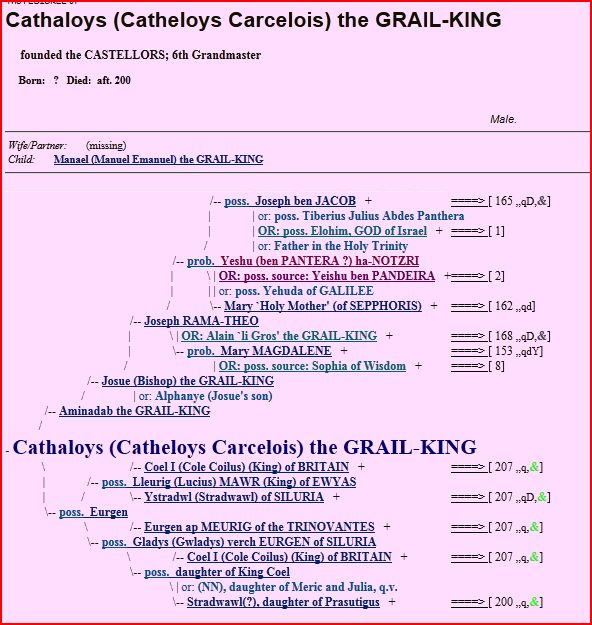Pendragons
Fisher Kings, Camelot & Grail Legends
From Scythia to Camelot
http://books.google.com/books?id=x9v0FaIgEFEC&printsec=frontcover#v=onepage&q&f=false
http://books.google.com/books?id=x9v0FaIgEFEC&printsec=frontcover#v=onepage&q&f=false
Evidence suggests that the tales of Arthur, Lancelot and other Knights were brought into Europe by various groups of invading Sarmatians and Alans. People sensed that the stories somehow belonged together, so they combined them. Variations reflect each invading group's history and traditions.
We do know that certain Celtic tribes had penetrated the Danube area as early as the fifth century B.c.E., and another far-flung Celtic tribe, the Cotini, seems to have had some contact with the Germanic Quadi and possibly with the Sarmatians in the same general region at the end of the first century c.E.
Campbell argued that the legends claiming that the Celts descended from a people from the East Mediterranean were true. It appears extremely doubtful, however, whether these eastern Celts could have transmitted the raw material from which the Ossetians later fashioned their heroic sagas, for the available evidence suggests that whatever their prototypes, the British legends about Arthur are not attested until at least the fifth century. Such details as the story of Arthur's death, which so remarkably parallels the Ossetic account of the death of Batraz, had probably not yet evolved in Europe—let alone diffused to what was then the other end of the Celtic-speaking world—at the time the Cotini and other eastern Celts might have been in contact with some Sarmatians.
The Lancelot and Grail material seem to be derived from the same source as the sagas of the Narts, and the agent of transmission was most likely the Alans of Gaul.
http://ossetians.com/eng/news.php?newsid=370
We do know that certain Celtic tribes had penetrated the Danube area as early as the fifth century B.c.E., and another far-flung Celtic tribe, the Cotini, seems to have had some contact with the Germanic Quadi and possibly with the Sarmatians in the same general region at the end of the first century c.E.
Campbell argued that the legends claiming that the Celts descended from a people from the East Mediterranean were true. It appears extremely doubtful, however, whether these eastern Celts could have transmitted the raw material from which the Ossetians later fashioned their heroic sagas, for the available evidence suggests that whatever their prototypes, the British legends about Arthur are not attested until at least the fifth century. Such details as the story of Arthur's death, which so remarkably parallels the Ossetic account of the death of Batraz, had probably not yet evolved in Europe—let alone diffused to what was then the other end of the Celtic-speaking world—at the time the Cotini and other eastern Celts might have been in contact with some Sarmatians.
The Lancelot and Grail material seem to be derived from the same source as the sagas of the Narts, and the agent of transmission was most likely the Alans of Gaul.
http://ossetians.com/eng/news.php?newsid=370
Sir William Russell Flint, illustration from 'Le Morte d'Arthur: The Book of King Arthur and his Noble Knights of the Round Table' Book IV Chapter I (circa 1910)
"So by her subtle working she made Merlin to go under that stone..."
"So by her subtle working she made Merlin to go under that stone..."
La Morrigan by Yoann Lossel
Joe Guerin
Merlin's Quest, Viviane Wood
Queen Mab
Prince Arthur and the Fairy Queen (c. 1788)
Masaaki Sasamoto
Uther the 'Chief Dragon':
The etymology of "Uther Pendragon" has led to much debate. The name Uther first arrives in literature in Nennius' Historia Brittonum, when he says Arthur was called "in British mab Uter, that is in Latin terrible son, because from his youth he was cruel." As such, when Geoffrey of Monmouth was writing his History of the Kings of Britain, he may have simply misunderstood and wrote that Arthur was the son of someone named Uther. If this is correct, then "Uther Pendragon" is the Welsh Ythr Pendragwn--"The Terrible {or Fearsome} Head-Dragon {Cheiftain}." On the other hand, the name appears independent of Geoffrey, and so the mistake may go back to Nennius, who is in the wrong. Either way, someone is wrong, and the name Uther is either an appelation of the father or of the son. There was a historical Arthur mac Aiden, of the Dal nRiada, but this was in the sixth century, and thus too late.
From Geoffrey onward, Uther (whatever his real name is) is the son of Constantus and brother of Ambrosius Aurelianus, who is a historical warlord that fough in the Battle of Badon Hill. Welsh geneaolgies have him decended from Maxen and Conan Meriadoc, leading ultimately up to old Llyr.
Uther is said to have become king after his father and brother are treacherously killed by Vortigern and the Saxons. In response, Uther has Merlin bury them at Stonehenge, which has been brought over from Ireland. Uther is able to defeat the Saxons, bringing some measure of peace to Britain. He falls in love with Igrain, the wife of the Duke of Cornwall (later called Gorlois), and has Merlin transform Uther's appearance into that of Gorlois, so that the king could sleep with her, thus begetting King Arthur in a move reminicent of Zeus' begetting of Hercules. Gorlois is killed in battle (not unlike the biblical husband of Bathsheba), and so Uther is free to marry her. After Arthur's birth, Merlin takes the boy to Sir Ector, and Uther reigns for many years. Various accounts are given of his death, but the typical one is of a murder, usually a poisoning of the water supply by the Saxons, who had recently lost a battle to him. He is then said to have been buried at Stonehenge with his brother.
Uther's name occurs in early Welsh poetry, in the Black Book of Carmarthen's poem "Pa Gwr," when Arthur lists as his servant "Mabon ap Modron, servant of Uthir Pen Dragon." This Mabon may be the Welsh god of youth, or it may be an appelation for Merlin, who is the Son of the Mother, having no father. The Book of Taliesin has a poem "The Elegy of Uther Pendragon," and another poem "The Elegy of Madoc" refers to "Uther's Son"--which may be Arthur, but which may be Madoc, who is sometimes named as a son of Uther.
An interesting idea, that Uther may have had another son who is rarely mentioned in Welsh literature--it leads to the question of why? Just as the question as to why Arthur's sons are written out of the story. Why is that? Because of some sort of embarressing failure? Some sort of traitorship? Or were they simply someone's invention?
(credit everything2.com)
The etymology of "Uther Pendragon" has led to much debate. The name Uther first arrives in literature in Nennius' Historia Brittonum, when he says Arthur was called "in British mab Uter, that is in Latin terrible son, because from his youth he was cruel." As such, when Geoffrey of Monmouth was writing his History of the Kings of Britain, he may have simply misunderstood and wrote that Arthur was the son of someone named Uther. If this is correct, then "Uther Pendragon" is the Welsh Ythr Pendragwn--"The Terrible {or Fearsome} Head-Dragon {Cheiftain}." On the other hand, the name appears independent of Geoffrey, and so the mistake may go back to Nennius, who is in the wrong. Either way, someone is wrong, and the name Uther is either an appelation of the father or of the son. There was a historical Arthur mac Aiden, of the Dal nRiada, but this was in the sixth century, and thus too late.
From Geoffrey onward, Uther (whatever his real name is) is the son of Constantus and brother of Ambrosius Aurelianus, who is a historical warlord that fough in the Battle of Badon Hill. Welsh geneaolgies have him decended from Maxen and Conan Meriadoc, leading ultimately up to old Llyr.
Uther is said to have become king after his father and brother are treacherously killed by Vortigern and the Saxons. In response, Uther has Merlin bury them at Stonehenge, which has been brought over from Ireland. Uther is able to defeat the Saxons, bringing some measure of peace to Britain. He falls in love with Igrain, the wife of the Duke of Cornwall (later called Gorlois), and has Merlin transform Uther's appearance into that of Gorlois, so that the king could sleep with her, thus begetting King Arthur in a move reminicent of Zeus' begetting of Hercules. Gorlois is killed in battle (not unlike the biblical husband of Bathsheba), and so Uther is free to marry her. After Arthur's birth, Merlin takes the boy to Sir Ector, and Uther reigns for many years. Various accounts are given of his death, but the typical one is of a murder, usually a poisoning of the water supply by the Saxons, who had recently lost a battle to him. He is then said to have been buried at Stonehenge with his brother.
Uther's name occurs in early Welsh poetry, in the Black Book of Carmarthen's poem "Pa Gwr," when Arthur lists as his servant "Mabon ap Modron, servant of Uthir Pen Dragon." This Mabon may be the Welsh god of youth, or it may be an appelation for Merlin, who is the Son of the Mother, having no father. The Book of Taliesin has a poem "The Elegy of Uther Pendragon," and another poem "The Elegy of Madoc" refers to "Uther's Son"--which may be Arthur, but which may be Madoc, who is sometimes named as a son of Uther.
An interesting idea, that Uther may have had another son who is rarely mentioned in Welsh literature--it leads to the question of why? Just as the question as to why Arthur's sons are written out of the story. Why is that? Because of some sort of embarressing failure? Some sort of traitorship? Or were they simply someone's invention?
(credit everything2.com)
Grail Dynasty from David and Solomon had progressed into the West, notably to the Merovingian kings of Gaul, while related branches established kingdoms in Ireland and Celtic Britain. These lines were linked through marriage to parallel Dragon strains from Ham, Japhet and Tubal Cain (which had survived as the royal houses of Scythia and Anatolia). The families had forged their own marital links with the early princesses of the Egyptian succession.
The first PenDragon (Head Dragon) of the Britannic Isle (Pen Draco Insularis). From this stock was King Cymbeline of the House of Camu, who was installed in about AD 10. The Celtic PenDragons were not father to son successors in a particular descent, but were individually elected from reigning family branches, by a Druidic council of elders, to be the overall Kings of Kings. The last PenDragon was Cadwaladr of Gwynedd, who died in AD 664. At around that time much of Britain fell to the Germanic influence of the invading Anglo Saxons and Angle land (England) was born, as distinct from Scotland and Wales.
The Merovingian-Arthurian Connection:
A major part of the Arthurian legends is that Arthur will rise from the dead and come back to protect the British people. Similar legends applied to the Visigoths, especially Alaric. One can still see today the sarcophage of Ragnachilde, Alaric’s mother, in the Musée des Augustins at Toulouse, sculpted with a scene representing the “resurrection of the son of the widow.” This seems a direct statement of the belief that Alaric would rise again from the dead.
It’s no surprise to hear that Alaric is sleeping in an underground chamber on the Montagne d’Alaric, until such a day when he can rise into battle to protect and save the people of Languedoc. Similarly, Arthur of Britain is a “sleeping warrior” who will return to rescue Britain when the time is right. There are such strong similarities between these stories; history in Britain and in France became mythic and coalesced into Grail legends.
The historical King Arthur
The first PenDragon (Head Dragon) of the Britannic Isle (Pen Draco Insularis). From this stock was King Cymbeline of the House of Camu, who was installed in about AD 10. The Celtic PenDragons were not father to son successors in a particular descent, but were individually elected from reigning family branches, by a Druidic council of elders, to be the overall Kings of Kings. The last PenDragon was Cadwaladr of Gwynedd, who died in AD 664. At around that time much of Britain fell to the Germanic influence of the invading Anglo Saxons and Angle land (England) was born, as distinct from Scotland and Wales.
The Merovingian-Arthurian Connection:
A major part of the Arthurian legends is that Arthur will rise from the dead and come back to protect the British people. Similar legends applied to the Visigoths, especially Alaric. One can still see today the sarcophage of Ragnachilde, Alaric’s mother, in the Musée des Augustins at Toulouse, sculpted with a scene representing the “resurrection of the son of the widow.” This seems a direct statement of the belief that Alaric would rise again from the dead.
It’s no surprise to hear that Alaric is sleeping in an underground chamber on the Montagne d’Alaric, until such a day when he can rise into battle to protect and save the people of Languedoc. Similarly, Arthur of Britain is a “sleeping warrior” who will return to rescue Britain when the time is right. There are such strong similarities between these stories; history in Britain and in France became mythic and coalesced into Grail legends.
The historical King Arthur
http://www.theheraldrysociety.com/articles/fictional_attributed/arthurian_arms.htm
Queen Mabh; Howard David Johnson
Alan Lee - Merlin
Merlin the Wizard, the Fairy Viviane, the Fairy Morgana, King Arthur … So many names which fill our imagination of dreams and fancies. But let us be a little bit realistic and we shall see that the reality removes not at all the magic of the History.
As we can see it in the presentation on the Nazareans rituals, the introduced women held personal meetings and respected a large number of rules and rites. These lunar rites reached us in the form of fragments hardly detectable at first sight, but it would seem that they continued in the person of Queens of Avallon who, for the European imagination were fairies in the real but unknown powers.
Taliesin the Bard whose legend will depict heroic deeds as Majesty Merlin the Wizard, skillful Councillor of young King Arthur Pendragon, was Archi-Druid and descendant of Yeshuah-Joseph. He married in 555, Avallon del Acqs's beautiful Viviane-Charis Queen, girl of supreme King of Avallon.
We know hardly few things of this kingdom of Avallon and his King, if it is, that in its death he handed his throne to his daughter Viviane-Charis and that the Salic law was not current in its kingdom. Viviane-Charis thus received Queen's responsibility and from High Priestess of Avallon at the same time. Quite as his father had exercised during numerous years the same royal and religious responsibility surrounded with companions, Viviane, her, surrounded himself with young Priestesses.
I have no sources to go back up the lineage of King Supreme of Avallon, but the political and religious organization of this man at once King and Priest, reminded that of the antique Jewish monarchy, with its messianic royal distribution ( Michpat) and of Priest ( Tzedek).
This King thus had to belong to the family of David's House or to the Asmonean House, with which King also performed the office of Priest. We could even suppose that when John the Hirkan annexed Auvergne in the Rhineland for the Tribe Sicambre, he left a descendant in the South of France, transmitted him the royal responsibility and Priest and handed him the Nazareans secrets. This branch cut by the Asmonean House would then have continued up to this King Supreme of Avallon.
However the rites and the gifts inherent to the Nazareans Seers meet with a big neatness 700 years later with Viviane-Charis of Avallon. Furthermore, the family of Jesus being always worried that his descendants get married only between them, the theory of an alliance between David's House and the Asmonean House would come to reproduce the plan of the marriage of Jesus with Marie-Madeleine and this idea would be rather attractive.
In brief, from there, both Houses, that of David and that of Avallon were going to unite their descendants strictly until form the lineage of Kings Unifiers of Small French Brittany whose first known ancestor will be Nominöé.
Viviane-Charis received the badge royal of the Bee, because becoming Queen, she became officially the "Bee queen". She so promised to her people to stay up him until the Sacrifice of herself. The bee was thus the symbol of its Consecration.
She was then taken on in the red dress of the royal lineage of Eve and in a long black cape with hood representing her attachment to Nazarean Holy Order. She knew that she would reach the highest rank of the High Priesthood only having brought into the world her first child, that is when Co-Creator with God, her would have realized his High Work by giving birth.
She then took the oath to serve always the Cult of the Goddess, Divine Presence (Shékinah Celestial Mother).
This cult, was bound to the moon and to the morning star and practised between Sisters. However, it is advisable to underline that the Celtic rites of the cycle of the Earth were added to the nazareans rites of the Priestesses of Avallon, what prevents from highlighting exactly the loans of the initial rites.
Morgana The Faye, the girl of Ygerne of Avallon and Gwyr Llew, Duke of Carlisle, the mother of Mordred son of Arthur Pendragon, Morgana will be the last Priestess d' Avalon.
The Cult returned in Divine presence had for main symbols the Moon (image of Shékinah), the Morning star (image of Shékinah), the spiritual language of the nature, the water, the wind and the cycle of the life. Nazareans were convinced that the Earth must be served by the Priestesses so that she in his turn can serve the children of the people and what the cycle of the seasons is not interrupted nor disrupted.
Viviane II Queen of Avallon del Acqs, the younger daughter of King Supreme of Avallon, married Banns Bénoïc de Septimanie and brought into the world in 560: Lancelot del Acqs (more known under the name of Lancelot du Lac). Lancelot will be the bravest of the ground knights, but he lost the right for the Celestial Chivalry because of his lack of chastity.
Kings Fisherman detaining the Ark of the New Covenance reserved a room which belonged only to its service. The Cup of the Holy Grail was put down. Any oath, any alliance was contracted in the presence of the Holy Grail.
The Initiatories were given in the form of initiation called Terrestrial Chivalry. If the Terrestrial Knight respected his oath and his covenances it was allowed to see spending the service of Grail at the time of Noon and in front of its door received his Endowment Celestial Chivalry.
Only Kings of the Family of Jesus having received their Celestial Chivalry could claim to be allowed in the presence of the Ark of the New Covenance and it was then a God himself by Saint Esprit who indicated the successor of the Carrier of present Grail.
The Carrier of Grail benefited from a big prestige in the family because they had to live a just life and had the reputation to be Saints on the earth. Lancelot was intended to receive the responsibility of Carrier of Grail from time immemorial, but he had failed in his oath of chastity. He had fallen in love with Queen Guinevere marry of King Arthur and diverted her from the duty with complete impunity because he enjoyed the friendship of King.
Lancelot did not thus receive the Celestial Chivalry and carried the pain throughout his life. He married Elaine de Septimanie girl of King Pelles the last Carrier of the Grail in 582. Arthur competed for the title of Carrier of Grail following King Pelles, but to become Pendragon he had sacrificed to the classic art Celtic tradition to have his first sexual intercourse with the Big Priestess of Avalon. This rite dedicated the earth to federative King of all the Bretons of Great and Small Brittany, but was against the oath of chastity contracted to receive the Terrestrial Chivalry. Arthur had thus eliminated himself and conceived a contained fury.
One day, it seemed to him to see appearing the Cup of the Holy Grail at the time of the rise, over the Priest Catholic who celebrated the mass. He deducted that from it he had to be next King Fisherman Carrier of the Grail and threw his knights in search of the sacred Cup. But Grail could not be contained by greed.
The Philistines had captured the Ark of the Covenant during their war against the Hebrew and they had removed only famine from it, plague and sadness. Also, King Arthur, by his greed, received many misfortunes in his life, in particular by having no heir of his union with Guinevere, by suffering multiple warlike chesses at the end of his life and by dying in the fight pulling the sword against Mordred, his son whom he had had incestuously with Morgana the Faye his half sister.
In 583, of his union with Elaine de Septimanie, Lancelot Del Acqs had the enjoyment to have a beautiful small heir whom he named Galahad. He blesses it by giving him his name and here is the words which he pronounced: " my dear son, pride of my old age, you will grow and will be a subject of enjoyment in heavens. You will achieve that your father had no strength to realize. You were born on this earth to achieve the intentions of the very high God and always, throughout your life, He will bless you. You have the beauty of your mother, the wisdom of your grand-father King Pelles and you will follow, spotless, God's paths. Be afraid of nothing, your faith will guide you and will help you to surmount all the tests. Your glance will remain pure and your crystal clear soul because you are a son of God, Son of the Light ". He sealed his blessing and looked his wife: she wept with joy. A new era had just opened, full of hope.
As we can see it in the presentation on the Nazareans rituals, the introduced women held personal meetings and respected a large number of rules and rites. These lunar rites reached us in the form of fragments hardly detectable at first sight, but it would seem that they continued in the person of Queens of Avallon who, for the European imagination were fairies in the real but unknown powers.
Taliesin the Bard whose legend will depict heroic deeds as Majesty Merlin the Wizard, skillful Councillor of young King Arthur Pendragon, was Archi-Druid and descendant of Yeshuah-Joseph. He married in 555, Avallon del Acqs's beautiful Viviane-Charis Queen, girl of supreme King of Avallon.
We know hardly few things of this kingdom of Avallon and his King, if it is, that in its death he handed his throne to his daughter Viviane-Charis and that the Salic law was not current in its kingdom. Viviane-Charis thus received Queen's responsibility and from High Priestess of Avallon at the same time. Quite as his father had exercised during numerous years the same royal and religious responsibility surrounded with companions, Viviane, her, surrounded himself with young Priestesses.
I have no sources to go back up the lineage of King Supreme of Avallon, but the political and religious organization of this man at once King and Priest, reminded that of the antique Jewish monarchy, with its messianic royal distribution ( Michpat) and of Priest ( Tzedek).
This King thus had to belong to the family of David's House or to the Asmonean House, with which King also performed the office of Priest. We could even suppose that when John the Hirkan annexed Auvergne in the Rhineland for the Tribe Sicambre, he left a descendant in the South of France, transmitted him the royal responsibility and Priest and handed him the Nazareans secrets. This branch cut by the Asmonean House would then have continued up to this King Supreme of Avallon.
However the rites and the gifts inherent to the Nazareans Seers meet with a big neatness 700 years later with Viviane-Charis of Avallon. Furthermore, the family of Jesus being always worried that his descendants get married only between them, the theory of an alliance between David's House and the Asmonean House would come to reproduce the plan of the marriage of Jesus with Marie-Madeleine and this idea would be rather attractive.
In brief, from there, both Houses, that of David and that of Avallon were going to unite their descendants strictly until form the lineage of Kings Unifiers of Small French Brittany whose first known ancestor will be Nominöé.
Viviane-Charis received the badge royal of the Bee, because becoming Queen, she became officially the "Bee queen". She so promised to her people to stay up him until the Sacrifice of herself. The bee was thus the symbol of its Consecration.
She was then taken on in the red dress of the royal lineage of Eve and in a long black cape with hood representing her attachment to Nazarean Holy Order. She knew that she would reach the highest rank of the High Priesthood only having brought into the world her first child, that is when Co-Creator with God, her would have realized his High Work by giving birth.
She then took the oath to serve always the Cult of the Goddess, Divine Presence (Shékinah Celestial Mother).
This cult, was bound to the moon and to the morning star and practised between Sisters. However, it is advisable to underline that the Celtic rites of the cycle of the Earth were added to the nazareans rites of the Priestesses of Avallon, what prevents from highlighting exactly the loans of the initial rites.
Morgana The Faye, the girl of Ygerne of Avallon and Gwyr Llew, Duke of Carlisle, the mother of Mordred son of Arthur Pendragon, Morgana will be the last Priestess d' Avalon.
The Cult returned in Divine presence had for main symbols the Moon (image of Shékinah), the Morning star (image of Shékinah), the spiritual language of the nature, the water, the wind and the cycle of the life. Nazareans were convinced that the Earth must be served by the Priestesses so that she in his turn can serve the children of the people and what the cycle of the seasons is not interrupted nor disrupted.
Viviane II Queen of Avallon del Acqs, the younger daughter of King Supreme of Avallon, married Banns Bénoïc de Septimanie and brought into the world in 560: Lancelot del Acqs (more known under the name of Lancelot du Lac). Lancelot will be the bravest of the ground knights, but he lost the right for the Celestial Chivalry because of his lack of chastity.
Kings Fisherman detaining the Ark of the New Covenance reserved a room which belonged only to its service. The Cup of the Holy Grail was put down. Any oath, any alliance was contracted in the presence of the Holy Grail.
The Initiatories were given in the form of initiation called Terrestrial Chivalry. If the Terrestrial Knight respected his oath and his covenances it was allowed to see spending the service of Grail at the time of Noon and in front of its door received his Endowment Celestial Chivalry.
Only Kings of the Family of Jesus having received their Celestial Chivalry could claim to be allowed in the presence of the Ark of the New Covenance and it was then a God himself by Saint Esprit who indicated the successor of the Carrier of present Grail.
The Carrier of Grail benefited from a big prestige in the family because they had to live a just life and had the reputation to be Saints on the earth. Lancelot was intended to receive the responsibility of Carrier of Grail from time immemorial, but he had failed in his oath of chastity. He had fallen in love with Queen Guinevere marry of King Arthur and diverted her from the duty with complete impunity because he enjoyed the friendship of King.
Lancelot did not thus receive the Celestial Chivalry and carried the pain throughout his life. He married Elaine de Septimanie girl of King Pelles the last Carrier of the Grail in 582. Arthur competed for the title of Carrier of Grail following King Pelles, but to become Pendragon he had sacrificed to the classic art Celtic tradition to have his first sexual intercourse with the Big Priestess of Avalon. This rite dedicated the earth to federative King of all the Bretons of Great and Small Brittany, but was against the oath of chastity contracted to receive the Terrestrial Chivalry. Arthur had thus eliminated himself and conceived a contained fury.
One day, it seemed to him to see appearing the Cup of the Holy Grail at the time of the rise, over the Priest Catholic who celebrated the mass. He deducted that from it he had to be next King Fisherman Carrier of the Grail and threw his knights in search of the sacred Cup. But Grail could not be contained by greed.
The Philistines had captured the Ark of the Covenant during their war against the Hebrew and they had removed only famine from it, plague and sadness. Also, King Arthur, by his greed, received many misfortunes in his life, in particular by having no heir of his union with Guinevere, by suffering multiple warlike chesses at the end of his life and by dying in the fight pulling the sword against Mordred, his son whom he had had incestuously with Morgana the Faye his half sister.
In 583, of his union with Elaine de Septimanie, Lancelot Del Acqs had the enjoyment to have a beautiful small heir whom he named Galahad. He blesses it by giving him his name and here is the words which he pronounced: " my dear son, pride of my old age, you will grow and will be a subject of enjoyment in heavens. You will achieve that your father had no strength to realize. You were born on this earth to achieve the intentions of the very high God and always, throughout your life, He will bless you. You have the beauty of your mother, the wisdom of your grand-father King Pelles and you will follow, spotless, God's paths. Be afraid of nothing, your faith will guide you and will help you to surmount all the tests. Your glance will remain pure and your crystal clear soul because you are a son of God, Son of the Light ". He sealed his blessing and looked his wife: she wept with joy. A new era had just opened, full of hope.
"N.C. Wyeth King Arthur, Lady of The Lake"
...Elven-Faerie Genelogical Chart Featuring Morgane Le Fey & Melusine....
The 'Lady of the Lake' & the Arthurian Tradition:
The Lady of the Lake is the name of several related characters who play integral parts in the Arthurian legend. These characters' roles include giving King Arthur his sword Excalibur, taking the dying king to Avalon after the Battle of Camlann, enchanting Merlin, and raising Lancelot after the death of his father. Different writers and copyists give her name variously as Nimue, Viviane, Elaine, Niniane, Nyneve, and other variations.
Origins
The Lady of the Lake's origins are probably ancient and pagan, like Morgan le Fay's, and she and Morgan may have ultimately derived from the same tradition. The first mention of Avalon, a magical island with which the Lady and Morgan are frequently associated, is in Geoffrey of Monmouth's Historia Regum Britanniae; Geoffrey says Arthur's sword Caliburn was forged there, and says Arthur was taken to the isle after his battle with Mordred to have his wounds healed.
Chrétien de Troyes mentions in his romance Lancelot, the Knight of the Cart that Lancelot had been raised by a water fay who gave him a magic-resisting ring. Lancelot's life with the Lady of the Lake is detailed in the German Lanzelet by Ulrich von Zatzikhoven and the Prose Lancelot Proper, which was later expanded into the Lancelot-Grail Cycle. There, the Lady of the Lake fosters the infant Lancelot after his father Ban has been killed fighting against his enemy Claudas. It has been suggested that these three works are derived from a lost tradition of Lancelot, which is perhaps best preserved in Ulrich's version.
The character has some similarities to the sea nymph Thetis of Greek mythology. Like the Lady of the Lake, Thetis is an aquatic spirit who raises the greatest warrior of her time (in this case, her son Achilles). Thetis' husband is Peleus, while the Lady of the Lake takes the knight Pelleas as her lover in some versions. Thetis uses magic to make her son invulnerable to harm and later gives him a shield and armor forged by the god Hephaestus, while the Arthurian character gives Lancelot a ring that protects him from all magic and delivers Excalibur to King Arthur. The Greek theme may have influenced or originated the tradition; the epic poem Iliad which features Thetis was popular both with the Romans, who occupied and colonized Great Britain and Brittany, and with the medieval scholars who wrote down the Celtic myths and oral traditions. The Lady of the Lake's guise as a water fay also makes her somewhat similar to Melusine.
In Medieval Literature Edit
The Lancelot-Grail Cycle provides a backstory for the Lady of the Lake, "Viviane", in the Prose Merlin section, which takes place before the Lancelot Proper, though it was written later. There, Viviane learns her magic from Merlin, who becomes enamored of her. She refuses to give him her love until he has taught her all his secrets, but when he does, she uses her power to trap him either in the trunk of a tree or beneath a stone, depending on the version. Because he could see the future, he knew this would happen, but was powerless to avoid it.
The Post-Vulgate Cycle omits the entire account of Lancelot's early adventures found in the Lancelot-Grail, and splits the Lady of the Lake's character in two. The first of these gives Arthur his sword Excalibur after he breaks his first one, but she demands he repay the favor at the time of her choosing. Some time later, she shows up at court and demands Arthur put the knight Sir Balin to death, explaining her family has had an ongoing blood feud with his. Instead, Balin chops off her head, and is banished from court. The Post-Vulgate's second Lady of the Lake is called "Ninianne", and her story is nearly identical to the one in the Lancelot-Grail. Sir Thomas Malory also uses both Ladies of the Lake in his Le Morte d'Arthur; he leaves the first one unnamed and calls the second one Nimue. The character appears in many other episodes of Malory's work....
(credit mythology.wikia.com)
The following article's original title was, "The Serpent Grail and the Lady of the Lake:..however, in reality, since the 'Grail' mythos, is simply a recapitulation (ie repackaging) of the ancient and esoteric Serpent-Goddess Tradition, I have chosen to re-title the following article...
The Arthurian 'Lady of the Lake' as a 'Primordial Tradition' Narrative:
Is mystery here to be unravelled? Is there a serpent code being held by the Grail myths? Can we uncover this code by taking a look at the Lady of Lake? The answer is yes to all these questions, for held within the folds of the coiled snake we shall discover the truth of the origin of the Arthurian tales and the strange watery Lady who was to give Arthur his sword.
There are various names attributed to the ‘Lady of the Lake;’ Nimue and Vivienne are the two most used, but most pertinent to us here is ‘White Serpent. ’ Nimue is probably Mneme or Mnemosyne, who is one of the Muses or ‘water nymphs’ from Roman and Greek mythology and who gave out weapons - just as the Lady of the Lake did. Vivienne in all likelihood comes from Vi-Vianna or Co-Vianna the ‘water goddess’ or Coventina of Celtic origin ('Coventina's Well’ also had a skull offering discovered which is important in the worship of snakes and wisdom [1]. )
These water deities are strongly related to the story of serpent worship, and united with the tale of the sword or weaponry, it introduces the duality of peace and war so well known in the serpent myths. The sword pierces and strikes and involves contemporaneously, the image of the serpent upon the blade via the unique metallurgy employed. This wonderful metallurgy of the Middle Ages and beyond reveals to us in actual artefacts that the serpent itself was fashioned into the blade as part of the process. This of course relates to the fact that Arthur's sword was said to be a fiery serpent in the Dream of Rhonabwy. When Arthur's sword is drawn it was said that two flames of fire burst out of the jaws of the two serpents, and so wonderful was the sword that it was hard for anyone to gaze at it. It is necessary for Arthur to maintain ownership of the sword, whether it is the sword from the stone or Excalibur, as it ensures his victory and his life. The infamous Arthurian writer, Malory, indicates the brightness of the sword and its fiery aspect, writing: “but it was so bright in his enemies eyes, that it gave light like thirty torches. " But the sword in the stone does not last long and the Lady of the Lake gives Arthur his Excalibur, and also a serpent scabbard, which ensures eternal life. Malory states quite clearly “for whiles ye have the scabbard upon you, ye shall never lose no blood, be ye never so sore wounded; therefore keep well the scabbard always with you. " It is only when Arthur's half sister Morgan le Fay steals the scabbard and replaces it that Arthur becomes susceptible to the deadly blows of Mordred. The once prized sword is then returned to the water, the home of the Lady of the Lake - the serpent spirit.
There is a remarkable resemblance between the tales of Arthur's sword and an unsuspecting Chinese legend. A hero from the 6th century BC named Wu Tzu-hsu threw his sword into a river “It shot forth like a spirit-glow, sparkling brightly as it thrice sank and thrice came to the surface with a great gush and then hovered above the water. The god of the river . . . heard the swords roar . . . he rolled in the waters in a great and frothing frenzy . . . Dragons raced along the waves and leaped out of the water. The river god held the sword in his hand and, frightened, told Wu Tzu-hsu to take it back. " (Mair 1983, 141 and 286. ) This story related in the 8th century AD simply cannot differ from Malory's tale of the sword. In China there were tales of great swords such as Dragon Spring and others still that leap into the waters surrounded by dragons, which churn up the water. Wu Tzu-hsu's sword is also called Dragon Spring. [2]
And this Dragon Spring carries us back again to the water nymphs who were seen universally as controlling the essential essence of life via their relationship with the healing waters, springs and lakes. Coventina was worshipped widely and it is highly likely that the Arthurian Morgan Le Fay is associated with her, as her name implies water nymph. There are also elements, which introduce her into the ‘Triple Goddess’ of the Celtic religion and therefore relating her to Bridgid. She was a great goddess of healing; linked strongly with water nymphs - and in relation to the sword she was also a great smith.
She also owned an apple orchard, which relates nicely to Avalon, the isle of apples. Her day is called Imbolc - around the 2nd February - but it is also known as Oimelc, Candlemas and in the USA as ‘Groundhog Day. ’ This special event in the American calendar involves of course the mass killing of snakes, and relates to the tale of Bridgid's snake, which comes out of the mound from which it had been hibernating.
At Oimelc it is said that the singers cry, “The day of Bride, the birthday of spring, The serpent emerges from the knoll. " And in winter, Scottish folk poems still speak of the serpent that dwells in the hillside.
As the ‘Lady of the Lake’ forged Arthur's sword, so too the various parts of these ancient goddesses simply must have been collated together in the form of this Arthurian water goddess - a new deity forged.
These goddesses, all basically the same, are also related to Sibyl or the Sibillia who presides over witches; and in the Ukraine one of the names for ‘witch’ actually means ‘snake, ’ and in Russia it was believed that witches had snake tails. This sheds more light on the idea that witches mixed their famous brews and elixirs in their cauldrons, very much like the cauldron such as the one discovered at Gundestrup. For if it is true what we uncovered in The Serpent Grail, then this brew was serpent venom and blood.
Sibillia has the ‘power over life’ and touches baskets and bottles with her wand to restore them afresh. Sibillia taught magical arts in her serpent grotto where shape-shifting fairies reminiscent of the naginis (female serpents) of India emerge and dance around. These fairies are said to turn into snakes each Saturday. Anyone who wished to enter this Sybil Cave must love snakes or suffer the consequences. Sibillia is also seen in the Life of Robin Goodfellow (similar to Robin Hood and which means “bright or shining hood") as Sib, who speaks for the fairies. She says that they live in “some great hill, and from thence we do lend money to any poore man or woman that hath need. " In the 15th century, Perceforest has her as the ‘Lady of the Lake. '
In Scottish myth one of these fairies lived inside a tree and often appeared holding a limpet shell containing the ‘milk of wisdom’ which was called the “copan Moire" or “Cup of Mary" in her hands - an obvious allusion to the ‘life-giving’ element and wisdom of these snake, shape-shifters remembered in legend.
There are many other tales, which link these European snake shape-shifters to the Nagas of India and we would just like to break off for a moment to take a look at these peculiar deities.
Naga is a Sanskrit term meaning literally Serpent (especially cobra) but it also holds the meanings - a tree; a mountain; the sun; the number seven; wisdom and initiate - all symbols and emblems we will become familiar with in the worship of the serpent. They are said to reside in Patala, however this has a meaning similar to antipodes, the same name given by the ancients to the America's. It is a similar term to the Mexican Nagals, the medicine (healers) and sorcerers who always kept a god in the shape of a serpent. In Burma they are Nats or serpent gods. Esoterically Naga is a term for wise men. There is a folk tradition that Nagas washed Gautama (Buddha) at his birth - the wise men visiting the deity on Earth and cleansing the enlightened one. They are also said to have guarded him and the relics of his body after his death.
According to H. P. Blavatsky in Theosophical Glossary, the Naga were descended from Rishi Kasyapa who had twelve wives (therefore he is the sun), by whom he had numerous Nagas (serpents) and was the father of all animals. Rishi Kasyapa can therefore be none other than a progenitor of the Green Man, and this explains the reasons for the appearance of the snake in images of the Green Man and Horned God, such as the Gundestrup Cauldron.
There is also a theory that the Nagas descended from the Scythic race and when the Brahmins invaded India they found a race of wise men, half gods, half demons (snakes). These men were said to be teachers of other nations and themselves instructed the Hindu's and Brahmans.
In the Bhagavata Purana there is a description of the Bila-svarga or the regions of the Nagas said to be subterranean. Some of the names associated with this place relate remarkably to the Mesoamerican and South American terms such as Tlaloc. “My dear king, beneath this earth are seven other planets [seven is important in Atlantean myths - seven islands!], known as Atala, Vitala, Sutala, Talatala, Mahatala, Rstala and Patala. . . the residents are known as Daityas, Danavas and Nagas . . . brilliantly decorated cities . . . wonderful houses, walls, gates, assembly houses, temples, yards and temple compounds . . . The houses for the leaders of these planets are constructed with the most valuable jewels, and are always crowded with the living entities known as Nagas and Asuras . . . Many great serpents reside there with gems on their hoods, and the effulgence of these gems dissipates the darkness in all directions. Since the residents of these planets drink and bathe in juices and elixirs made from wonderful herbs, they are freed from all anxieties and physical diseases. They have no experience of gray hair, wrinkles or invalidity. " (Bhagavata Purana)
There is currently a lot of debate about the original inhabitants of India - whether Aryan or Naga, but the fact remains, whether the Nagas were Aryans or not, they were an ancient inhabitant. The very fact that they were mentioned in the ancient Rig Vedas shows this to be true. They also intermarried with the Royal families, hence the popular myths of serpent kings.
"Then come the Naaga, the Siren serpents, whose worship has been so important a factor in the folklore, superstition, and poetry of India from the earliest times down to-day. Cobras in their ordinary shape, they lived, like mermen and mermaids, more beneath the water, in a great luxury and wealth, more especially of germ, and sometimes, as we shall see, the name is used of the Dryads, the tree-spirits, equally wealthy and powerful. They could at will and often did, adopt the human form and though terrible if angered, were kindly and mild by nature. Not mentioned either in the Veda or in the pre-Buddhist Upanishads, the myth seems to be a strange jumble of beliefs, not altogether pleasant, about a strangely gifted race of actual men; combined with notions derived from previously existing theories of tree worship, and serpent worship, and river worship. But the history of the idea has still to be written. The Naagas are represented on the ancient bas-reliefs as men or women either with cobra's hoods rising behind their heads or with serpentine forms from their waist downwards. " Rhys Davies, Buddhist India, p.223.
These tree deities were Nagas anyway as Rhys Davies continues on page 223 “The tree-deities were called Naagas, and were able at will, like the Naagas, to assume the human form and in one story the spirit of a Nunyan tree who reduced the merchants to ashes is called a Naaga-raja, the tree itself is a dwelling place of Naaga. It seems that they also left behind myths of healing as a story in the Journal of the Bombay Branch of the Asiatic Society demonstrates. When there was an epidemic among the children, it seems the only answer was to bring them to a snake skin which was hung on a pole and allow them to touch it - reminding us of the idea of the Brazen Serpent of Moses, which was upon a pole and for the healing of the “children" of Israel. This may explain why it is that the tree-gods are not specially and separately mentioned in the Maha Samaya list of deities who are there said by the poet to have come to pay reverence to the Buddha. "
The history of the Nagas that we do have, textually beginning around the 7th century BC is an amazing history of ups and downs. It parallels the rise and fall of the serpent worshipped by the Semites, with the Brazen Serpent being raised in the wilderness and then broken up in the temple. Like Melusine and Sibillia, Tante Arie also loved to plunge into cool pools in her caverns of Milandre where she changed into a vouivre or serpent; bringing to mind the concept that the shape-shifting Nagas of India which were said to reside in the underwater realms. Surely these ladies of ancient lore are folk memories of serpent worshipping leaders from the past - and a positively feminine one at that. The Nagas were also said to have jewels in their foreheads, like many other serpents from legend. As if knowing this, the vouivre too wears a jewel in the middle of her forehead. The Nagas are also said to protect great treasure, so too do the ladies of European lore.
We know that the Scythians were great worshippers of the serpent from many sources - as in the bracelets found, which the women wore as symbols of fertility. The Scythians were intimately linked with the Naga, serpent worshippers of India via trade and war. They came to Europe via several means - one of them as hired hands of the Romans, and in this way crept into the Arthurian legend. Herodotus tells us of an account of the Scythian snake goddess who was mistress of the land where the Dniepr flowed into the Black Sea. This Scythian serpent goddess was also a cave dweller.
The xana serpent goddesses of Asturias even had a sacred and valuable chalice stolen by a human, only to eventually deposit the famed cup in a Church - thus taking the sacred cup from the serpent and giving it to Christianity. These xana's kept their treasures in a “serpent cave" immersed in pools, remarkably like the Patala of the Nagas. In Wales the serpents were said to emerge and congregate on Midsummer's Eve to blow into the Serpent Stones / Eggs or Glain Neidr which is reminiscent of Pliny's tale of this activity amongst the Gauls. The snakes are said to create eggs or alternatively ‘new life. ’ In Wales these serpent stones were said to be coloured pebbles, which gave ‘second sight’ and healing.
Midsummer's Eve was the night when the serpents would role themselves into hissing balls and create the glain egg, also known as ‘snake stone’ or ‘Druid's egg. ’ In Welsh myth even Merlin himself went in search of them.
Victor H. Mair of the University of Pennsylvania also points to the association between the Scythian and the Arthurian tales: “The Nart sagas [repositories of Scythian traditions] contain parallels with Arthurian legend so numerous and so uncannily close that it is impossible they are unrelated. "
Interestingly, remains of these Scythians have been found on the Silk Road to China. Remains here of Caucasians dates back even before that and at present stand somewhere in the region of 3,000 years BC, with female Shaman being buried in full regalia, tattoos of spirals and zig zags and long finger nails. This in itself shows the widespread travel of these Scythians or those like them and the transport of ideas, possible many thousands of years ago. In China of course, we find the serpents or dragons as friendly creatures who become the ancestors of the very Emperor's themselves and seep into Chinese alchemy as symbols of the Elixir.
So, in summing up, what do we have? We have serpent deities, across the world, living in underwater kingdoms, making great weapons and guarding wondrous treasures. We have etymology linking them to the Lady of the Lake and we have Arthurian links and Grail connections through the mighty warrior race of the Scythians. In short, we have here, the truth of the Lady herself and the origin of the Grail mythos is yet again to be found within the tale of the snake. History, it seems, needs re-appraising.
(credit Philip Gardiner)
The Lady of the Lake is the name of several related characters who play integral parts in the Arthurian legend. These characters' roles include giving King Arthur his sword Excalibur, taking the dying king to Avalon after the Battle of Camlann, enchanting Merlin, and raising Lancelot after the death of his father. Different writers and copyists give her name variously as Nimue, Viviane, Elaine, Niniane, Nyneve, and other variations.
Origins
The Lady of the Lake's origins are probably ancient and pagan, like Morgan le Fay's, and she and Morgan may have ultimately derived from the same tradition. The first mention of Avalon, a magical island with which the Lady and Morgan are frequently associated, is in Geoffrey of Monmouth's Historia Regum Britanniae; Geoffrey says Arthur's sword Caliburn was forged there, and says Arthur was taken to the isle after his battle with Mordred to have his wounds healed.
Chrétien de Troyes mentions in his romance Lancelot, the Knight of the Cart that Lancelot had been raised by a water fay who gave him a magic-resisting ring. Lancelot's life with the Lady of the Lake is detailed in the German Lanzelet by Ulrich von Zatzikhoven and the Prose Lancelot Proper, which was later expanded into the Lancelot-Grail Cycle. There, the Lady of the Lake fosters the infant Lancelot after his father Ban has been killed fighting against his enemy Claudas. It has been suggested that these three works are derived from a lost tradition of Lancelot, which is perhaps best preserved in Ulrich's version.
The character has some similarities to the sea nymph Thetis of Greek mythology. Like the Lady of the Lake, Thetis is an aquatic spirit who raises the greatest warrior of her time (in this case, her son Achilles). Thetis' husband is Peleus, while the Lady of the Lake takes the knight Pelleas as her lover in some versions. Thetis uses magic to make her son invulnerable to harm and later gives him a shield and armor forged by the god Hephaestus, while the Arthurian character gives Lancelot a ring that protects him from all magic and delivers Excalibur to King Arthur. The Greek theme may have influenced or originated the tradition; the epic poem Iliad which features Thetis was popular both with the Romans, who occupied and colonized Great Britain and Brittany, and with the medieval scholars who wrote down the Celtic myths and oral traditions. The Lady of the Lake's guise as a water fay also makes her somewhat similar to Melusine.
In Medieval Literature Edit
The Lancelot-Grail Cycle provides a backstory for the Lady of the Lake, "Viviane", in the Prose Merlin section, which takes place before the Lancelot Proper, though it was written later. There, Viviane learns her magic from Merlin, who becomes enamored of her. She refuses to give him her love until he has taught her all his secrets, but when he does, she uses her power to trap him either in the trunk of a tree or beneath a stone, depending on the version. Because he could see the future, he knew this would happen, but was powerless to avoid it.
The Post-Vulgate Cycle omits the entire account of Lancelot's early adventures found in the Lancelot-Grail, and splits the Lady of the Lake's character in two. The first of these gives Arthur his sword Excalibur after he breaks his first one, but she demands he repay the favor at the time of her choosing. Some time later, she shows up at court and demands Arthur put the knight Sir Balin to death, explaining her family has had an ongoing blood feud with his. Instead, Balin chops off her head, and is banished from court. The Post-Vulgate's second Lady of the Lake is called "Ninianne", and her story is nearly identical to the one in the Lancelot-Grail. Sir Thomas Malory also uses both Ladies of the Lake in his Le Morte d'Arthur; he leaves the first one unnamed and calls the second one Nimue. The character appears in many other episodes of Malory's work....
(credit mythology.wikia.com)
The following article's original title was, "The Serpent Grail and the Lady of the Lake:..however, in reality, since the 'Grail' mythos, is simply a recapitulation (ie repackaging) of the ancient and esoteric Serpent-Goddess Tradition, I have chosen to re-title the following article...
The Arthurian 'Lady of the Lake' as a 'Primordial Tradition' Narrative:
Is mystery here to be unravelled? Is there a serpent code being held by the Grail myths? Can we uncover this code by taking a look at the Lady of Lake? The answer is yes to all these questions, for held within the folds of the coiled snake we shall discover the truth of the origin of the Arthurian tales and the strange watery Lady who was to give Arthur his sword.
There are various names attributed to the ‘Lady of the Lake;’ Nimue and Vivienne are the two most used, but most pertinent to us here is ‘White Serpent. ’ Nimue is probably Mneme or Mnemosyne, who is one of the Muses or ‘water nymphs’ from Roman and Greek mythology and who gave out weapons - just as the Lady of the Lake did. Vivienne in all likelihood comes from Vi-Vianna or Co-Vianna the ‘water goddess’ or Coventina of Celtic origin ('Coventina's Well’ also had a skull offering discovered which is important in the worship of snakes and wisdom [1]. )
These water deities are strongly related to the story of serpent worship, and united with the tale of the sword or weaponry, it introduces the duality of peace and war so well known in the serpent myths. The sword pierces and strikes and involves contemporaneously, the image of the serpent upon the blade via the unique metallurgy employed. This wonderful metallurgy of the Middle Ages and beyond reveals to us in actual artefacts that the serpent itself was fashioned into the blade as part of the process. This of course relates to the fact that Arthur's sword was said to be a fiery serpent in the Dream of Rhonabwy. When Arthur's sword is drawn it was said that two flames of fire burst out of the jaws of the two serpents, and so wonderful was the sword that it was hard for anyone to gaze at it. It is necessary for Arthur to maintain ownership of the sword, whether it is the sword from the stone or Excalibur, as it ensures his victory and his life. The infamous Arthurian writer, Malory, indicates the brightness of the sword and its fiery aspect, writing: “but it was so bright in his enemies eyes, that it gave light like thirty torches. " But the sword in the stone does not last long and the Lady of the Lake gives Arthur his Excalibur, and also a serpent scabbard, which ensures eternal life. Malory states quite clearly “for whiles ye have the scabbard upon you, ye shall never lose no blood, be ye never so sore wounded; therefore keep well the scabbard always with you. " It is only when Arthur's half sister Morgan le Fay steals the scabbard and replaces it that Arthur becomes susceptible to the deadly blows of Mordred. The once prized sword is then returned to the water, the home of the Lady of the Lake - the serpent spirit.
There is a remarkable resemblance between the tales of Arthur's sword and an unsuspecting Chinese legend. A hero from the 6th century BC named Wu Tzu-hsu threw his sword into a river “It shot forth like a spirit-glow, sparkling brightly as it thrice sank and thrice came to the surface with a great gush and then hovered above the water. The god of the river . . . heard the swords roar . . . he rolled in the waters in a great and frothing frenzy . . . Dragons raced along the waves and leaped out of the water. The river god held the sword in his hand and, frightened, told Wu Tzu-hsu to take it back. " (Mair 1983, 141 and 286. ) This story related in the 8th century AD simply cannot differ from Malory's tale of the sword. In China there were tales of great swords such as Dragon Spring and others still that leap into the waters surrounded by dragons, which churn up the water. Wu Tzu-hsu's sword is also called Dragon Spring. [2]
And this Dragon Spring carries us back again to the water nymphs who were seen universally as controlling the essential essence of life via their relationship with the healing waters, springs and lakes. Coventina was worshipped widely and it is highly likely that the Arthurian Morgan Le Fay is associated with her, as her name implies water nymph. There are also elements, which introduce her into the ‘Triple Goddess’ of the Celtic religion and therefore relating her to Bridgid. She was a great goddess of healing; linked strongly with water nymphs - and in relation to the sword she was also a great smith.
She also owned an apple orchard, which relates nicely to Avalon, the isle of apples. Her day is called Imbolc - around the 2nd February - but it is also known as Oimelc, Candlemas and in the USA as ‘Groundhog Day. ’ This special event in the American calendar involves of course the mass killing of snakes, and relates to the tale of Bridgid's snake, which comes out of the mound from which it had been hibernating.
At Oimelc it is said that the singers cry, “The day of Bride, the birthday of spring, The serpent emerges from the knoll. " And in winter, Scottish folk poems still speak of the serpent that dwells in the hillside.
As the ‘Lady of the Lake’ forged Arthur's sword, so too the various parts of these ancient goddesses simply must have been collated together in the form of this Arthurian water goddess - a new deity forged.
These goddesses, all basically the same, are also related to Sibyl or the Sibillia who presides over witches; and in the Ukraine one of the names for ‘witch’ actually means ‘snake, ’ and in Russia it was believed that witches had snake tails. This sheds more light on the idea that witches mixed their famous brews and elixirs in their cauldrons, very much like the cauldron such as the one discovered at Gundestrup. For if it is true what we uncovered in The Serpent Grail, then this brew was serpent venom and blood.
Sibillia has the ‘power over life’ and touches baskets and bottles with her wand to restore them afresh. Sibillia taught magical arts in her serpent grotto where shape-shifting fairies reminiscent of the naginis (female serpents) of India emerge and dance around. These fairies are said to turn into snakes each Saturday. Anyone who wished to enter this Sybil Cave must love snakes or suffer the consequences. Sibillia is also seen in the Life of Robin Goodfellow (similar to Robin Hood and which means “bright or shining hood") as Sib, who speaks for the fairies. She says that they live in “some great hill, and from thence we do lend money to any poore man or woman that hath need. " In the 15th century, Perceforest has her as the ‘Lady of the Lake. '
In Scottish myth one of these fairies lived inside a tree and often appeared holding a limpet shell containing the ‘milk of wisdom’ which was called the “copan Moire" or “Cup of Mary" in her hands - an obvious allusion to the ‘life-giving’ element and wisdom of these snake, shape-shifters remembered in legend.
There are many other tales, which link these European snake shape-shifters to the Nagas of India and we would just like to break off for a moment to take a look at these peculiar deities.
Naga is a Sanskrit term meaning literally Serpent (especially cobra) but it also holds the meanings - a tree; a mountain; the sun; the number seven; wisdom and initiate - all symbols and emblems we will become familiar with in the worship of the serpent. They are said to reside in Patala, however this has a meaning similar to antipodes, the same name given by the ancients to the America's. It is a similar term to the Mexican Nagals, the medicine (healers) and sorcerers who always kept a god in the shape of a serpent. In Burma they are Nats or serpent gods. Esoterically Naga is a term for wise men. There is a folk tradition that Nagas washed Gautama (Buddha) at his birth - the wise men visiting the deity on Earth and cleansing the enlightened one. They are also said to have guarded him and the relics of his body after his death.
According to H. P. Blavatsky in Theosophical Glossary, the Naga were descended from Rishi Kasyapa who had twelve wives (therefore he is the sun), by whom he had numerous Nagas (serpents) and was the father of all animals. Rishi Kasyapa can therefore be none other than a progenitor of the Green Man, and this explains the reasons for the appearance of the snake in images of the Green Man and Horned God, such as the Gundestrup Cauldron.
There is also a theory that the Nagas descended from the Scythic race and when the Brahmins invaded India they found a race of wise men, half gods, half demons (snakes). These men were said to be teachers of other nations and themselves instructed the Hindu's and Brahmans.
In the Bhagavata Purana there is a description of the Bila-svarga or the regions of the Nagas said to be subterranean. Some of the names associated with this place relate remarkably to the Mesoamerican and South American terms such as Tlaloc. “My dear king, beneath this earth are seven other planets [seven is important in Atlantean myths - seven islands!], known as Atala, Vitala, Sutala, Talatala, Mahatala, Rstala and Patala. . . the residents are known as Daityas, Danavas and Nagas . . . brilliantly decorated cities . . . wonderful houses, walls, gates, assembly houses, temples, yards and temple compounds . . . The houses for the leaders of these planets are constructed with the most valuable jewels, and are always crowded with the living entities known as Nagas and Asuras . . . Many great serpents reside there with gems on their hoods, and the effulgence of these gems dissipates the darkness in all directions. Since the residents of these planets drink and bathe in juices and elixirs made from wonderful herbs, they are freed from all anxieties and physical diseases. They have no experience of gray hair, wrinkles or invalidity. " (Bhagavata Purana)
There is currently a lot of debate about the original inhabitants of India - whether Aryan or Naga, but the fact remains, whether the Nagas were Aryans or not, they were an ancient inhabitant. The very fact that they were mentioned in the ancient Rig Vedas shows this to be true. They also intermarried with the Royal families, hence the popular myths of serpent kings.
"Then come the Naaga, the Siren serpents, whose worship has been so important a factor in the folklore, superstition, and poetry of India from the earliest times down to-day. Cobras in their ordinary shape, they lived, like mermen and mermaids, more beneath the water, in a great luxury and wealth, more especially of germ, and sometimes, as we shall see, the name is used of the Dryads, the tree-spirits, equally wealthy and powerful. They could at will and often did, adopt the human form and though terrible if angered, were kindly and mild by nature. Not mentioned either in the Veda or in the pre-Buddhist Upanishads, the myth seems to be a strange jumble of beliefs, not altogether pleasant, about a strangely gifted race of actual men; combined with notions derived from previously existing theories of tree worship, and serpent worship, and river worship. But the history of the idea has still to be written. The Naagas are represented on the ancient bas-reliefs as men or women either with cobra's hoods rising behind their heads or with serpentine forms from their waist downwards. " Rhys Davies, Buddhist India, p.223.
These tree deities were Nagas anyway as Rhys Davies continues on page 223 “The tree-deities were called Naagas, and were able at will, like the Naagas, to assume the human form and in one story the spirit of a Nunyan tree who reduced the merchants to ashes is called a Naaga-raja, the tree itself is a dwelling place of Naaga. It seems that they also left behind myths of healing as a story in the Journal of the Bombay Branch of the Asiatic Society demonstrates. When there was an epidemic among the children, it seems the only answer was to bring them to a snake skin which was hung on a pole and allow them to touch it - reminding us of the idea of the Brazen Serpent of Moses, which was upon a pole and for the healing of the “children" of Israel. This may explain why it is that the tree-gods are not specially and separately mentioned in the Maha Samaya list of deities who are there said by the poet to have come to pay reverence to the Buddha. "
The history of the Nagas that we do have, textually beginning around the 7th century BC is an amazing history of ups and downs. It parallels the rise and fall of the serpent worshipped by the Semites, with the Brazen Serpent being raised in the wilderness and then broken up in the temple. Like Melusine and Sibillia, Tante Arie also loved to plunge into cool pools in her caverns of Milandre where she changed into a vouivre or serpent; bringing to mind the concept that the shape-shifting Nagas of India which were said to reside in the underwater realms. Surely these ladies of ancient lore are folk memories of serpent worshipping leaders from the past - and a positively feminine one at that. The Nagas were also said to have jewels in their foreheads, like many other serpents from legend. As if knowing this, the vouivre too wears a jewel in the middle of her forehead. The Nagas are also said to protect great treasure, so too do the ladies of European lore.
We know that the Scythians were great worshippers of the serpent from many sources - as in the bracelets found, which the women wore as symbols of fertility. The Scythians were intimately linked with the Naga, serpent worshippers of India via trade and war. They came to Europe via several means - one of them as hired hands of the Romans, and in this way crept into the Arthurian legend. Herodotus tells us of an account of the Scythian snake goddess who was mistress of the land where the Dniepr flowed into the Black Sea. This Scythian serpent goddess was also a cave dweller.
The xana serpent goddesses of Asturias even had a sacred and valuable chalice stolen by a human, only to eventually deposit the famed cup in a Church - thus taking the sacred cup from the serpent and giving it to Christianity. These xana's kept their treasures in a “serpent cave" immersed in pools, remarkably like the Patala of the Nagas. In Wales the serpents were said to emerge and congregate on Midsummer's Eve to blow into the Serpent Stones / Eggs or Glain Neidr which is reminiscent of Pliny's tale of this activity amongst the Gauls. The snakes are said to create eggs or alternatively ‘new life. ’ In Wales these serpent stones were said to be coloured pebbles, which gave ‘second sight’ and healing.
Midsummer's Eve was the night when the serpents would role themselves into hissing balls and create the glain egg, also known as ‘snake stone’ or ‘Druid's egg. ’ In Welsh myth even Merlin himself went in search of them.
Victor H. Mair of the University of Pennsylvania also points to the association between the Scythian and the Arthurian tales: “The Nart sagas [repositories of Scythian traditions] contain parallels with Arthurian legend so numerous and so uncannily close that it is impossible they are unrelated. "
Interestingly, remains of these Scythians have been found on the Silk Road to China. Remains here of Caucasians dates back even before that and at present stand somewhere in the region of 3,000 years BC, with female Shaman being buried in full regalia, tattoos of spirals and zig zags and long finger nails. This in itself shows the widespread travel of these Scythians or those like them and the transport of ideas, possible many thousands of years ago. In China of course, we find the serpents or dragons as friendly creatures who become the ancestors of the very Emperor's themselves and seep into Chinese alchemy as symbols of the Elixir.
So, in summing up, what do we have? We have serpent deities, across the world, living in underwater kingdoms, making great weapons and guarding wondrous treasures. We have etymology linking them to the Lady of the Lake and we have Arthurian links and Grail connections through the mighty warrior race of the Scythians. In short, we have here, the truth of the Lady herself and the origin of the Grail mythos is yet again to be found within the tale of the snake. History, it seems, needs re-appraising.
(credit Philip Gardiner)
- The Dragon King was known as the King of Kings and his symbol, Draco, represented his succession through the Egyptian pharaohs, the Egyptian Therapeutae, the Qumran Essenes to the Merovingian kings of Europe.
"In times of battle, when the armies of different kingdoms were conjoined, an overall leader was chosen and he was called the 'Great Dragon' (the 'King of Kings') - or, as we better know the name in its old Celtic form, the 'Pendragon'...
"In pictorial representation, the Messianic Dragon was, in essence, a large-jawed serpent with four legs, very much like a crocodile or a monitor. This was the Sacred Messeh whose name was 'Draco.' Draco was a divine emblem of the Egyptian pharaohs, a symbol of the Egyptian Therapeutate, of the Essenes of Qumran, and was the Bistea Neptunis (the sea serpent) of the descendant Merovingian Fisher-Kings in Europe." (Laurence Gardner) - 612 (Part I)
- The Druidic Dragon King or Pendragon, also called the King of Kings, was chosen by a Council of Elders to rule over all the kingdoms.
"...Cymbeline was the 'Pendragon' of mainland Britain during Jesus's lifetime. The Pendragon, or 'Head Dragon of the Island'...was the King-of-Kings and 'Guardian of the Celtic Isle'. The title was not dynastic; Pendragons were appointed from Celtic royal stock by a Druidic council of elders...
"The concept of the dragon in Celtic mythology emerged directly from the holy crocodile (the Messeh) of the ancient Egyptians. The Pharaohs were anointed with crocodile fat, and thereby attained the fortitude of the Messeh (Thus Messiah -- Anointed One). The image of the intrepid Messeh evolved to become the Dragon, which in turn became emblematic of mighty kingship.
"The Celtic Kings in Britain were called 'dragons' in the ancient Messeh tradition as intrepid guardians. But there were many separate kingdoms in those days before England gained an overall monarch in Saxon times. It was therefore necessary to appoint a King-of-Kings -- a High King to preside overall, and to lead combined armies from different tribal areas. The first Pendragon (Head Dragon/High King) was Cymbeline." - 29:183
"...Columba...in 574, had crowned and anointed King Aedan mac Gabran of Dalriada (Celtic Pendragon and father of King Arthur) - the first British monarch to be installed by priestly ordination - and this greatly upset the Church of Rome." - 92:30
- The Druidic Pendragon was passed on to the Merovingian kings in 666 A.D.
"In 666, probably still in Ireland, Dagobert married Mathilde, a Celtic princess." - 31:247
"The Merovingian kings were noted sorcerers in the manner of the Samaritan Magi..." - 29:171
"There was a very great 'Jewish' component among the Sicambrian Franks/Merovingians and, because they practiced polygamy (another Merovingian peculiarity) they left a great number of offspring. These aristocratic Merovingian children married into almost all of the noble families of Europe during the 5th, 6th, and 7th centuries. This has prompted more than one historian to suggest that the foundation of European nobility is Jewish!" - 261:180
"There are at least a dozen families in Britain and Europe today -- with numerous collateral branches -- who are of Merovingian lineage. These include the House of Hapsburg-Lorraine... Plantard, Luxembourg, Montpezat, Montesque, and various others. According to the 'Prieuré documents' the Sinclair family in Britain is also allied to the bloodline, as are various branches of the Stuarts... In many of its documents the Sion asserts that the new king, in accordance with Merovingian tradition, would 'rule but not govern'. In other words he would be a priest-king who functions primarily in a ritual and symbolic capacity; and the actual business of governing would be handled by someone else -- conceivably by the Prieuré de Sion." - 31:409-10
King Arthur
Queens of Avalon
单击此处进行编辑。
Lancelot
Sir Galahad by Robert Burns
The Lady of the Lake
The Tradition: The Lady of the Lake was the foster-mother of Sir Lancelot and raised him beneath the murky waters of her Lake. She is, however, best known for her presentation to King Arthur of his magical sword Excalibur, through the intervention of the King's druidic advisor, Merlin (Myrddin) who was constantly worried that his monarch would fall in battle.
Merlin had met the Lady at the Fountain of Barenton (Brittany) and fallen so deeply in love with her that he agreed to teach her all his mystical powers. The lady became Merlin's scribe, who recorded his prophecies, as well as his lover. Unfortunately however, over the years, the Lady became so powerful that her magical skills outshone even her teacher and she imprisoned him in Glass Tower (or similar dungeon). To some extent she stepped into Merlin's role at King Arthur's side, but the old man's removal contributed considerably to the great monarch's downfall. The Lady of the Lake was eventually obliged to reclaim her sword when Arthur was fatally wounded at the Battle of Camlann and Excalibur was hurled back to misty waters. She was later one of the three Queens who escorted the King to Avalon.
Her Name: The Lady of the Lake is usually referred to by various spellings of the names Nimue or Vivienne. Nimue is thought to be related to Mneme, the shortened form of Mnemosyne, one of the nine water-nymph Muses of Roman and Greek Mythology who gave weapons, not unlike Arthur's sword, to the heroic Perseus. Vivienne betrays the Lady's Celtic form, for "Vi-Vianna" probably derives from "Co-Vianna", a variant of the widespread Celtic water-goddess, Coventina. Remembering Latin pronunciation, this name probably relates to Merlin's original partner in early poetry, his wife Gwendoloena. Thus Gw-end(-ol)-oena = Cov-ent-ina. There have also been attempts to show Vivienne as a corrupt form of Diana or Rhiannon. Though possible, these theories seem unlikely.
Ancient Origins: Water deities were extremely popular with Celtic Society for they controlled the essential essence of life itself. The spontaneous movement of springs, rivers and lakes clearly showed the supernatural powers of the goddesses who lived within; and offerings at such aquatic features were commonplace, especially of weapons and other valuables. The practice continues today at wishing wells across the country, and the Lady of the Lake is remembered as "Lady Luck"!
Her names clearly reveal this Lady to have been the Celtic Water-Goddess Coventina (presumably identified by the Romans with their Mnemosyne). This lady was worshipped throughout the Western Roman Empire, in Britain, the Narbonne area of Gaul and North-Western Iberia too. She is most celebrated for her shrine at Brocolitia (Carrawburgh) on Hadrian's Wall. Here a quadrangular temple surrounded a central pool fed by a sacred spring. Coin, jewellery and small bronze figurine offerings have been excavated as well as numerous altars dedicated by the local soldiers.
Since the Lady of the Lake's place as Merlin's student and lover was largely overtaken by Morgan Le Fay, a lady whose very name in Breton indicates a water-nymph, it seems that the two were aspects of the same character. Indeed, as both appear among the three queens who escort Arthur to Avalon, she no doubt had a third aspect making up the well-known theme of a Celtic Triple-Goddess.
The Tradition: The Lady of the Lake was the foster-mother of Sir Lancelot and raised him beneath the murky waters of her Lake. She is, however, best known for her presentation to King Arthur of his magical sword Excalibur, through the intervention of the King's druidic advisor, Merlin (Myrddin) who was constantly worried that his monarch would fall in battle.
Merlin had met the Lady at the Fountain of Barenton (Brittany) and fallen so deeply in love with her that he agreed to teach her all his mystical powers. The lady became Merlin's scribe, who recorded his prophecies, as well as his lover. Unfortunately however, over the years, the Lady became so powerful that her magical skills outshone even her teacher and she imprisoned him in Glass Tower (or similar dungeon). To some extent she stepped into Merlin's role at King Arthur's side, but the old man's removal contributed considerably to the great monarch's downfall. The Lady of the Lake was eventually obliged to reclaim her sword when Arthur was fatally wounded at the Battle of Camlann and Excalibur was hurled back to misty waters. She was later one of the three Queens who escorted the King to Avalon.
Her Name: The Lady of the Lake is usually referred to by various spellings of the names Nimue or Vivienne. Nimue is thought to be related to Mneme, the shortened form of Mnemosyne, one of the nine water-nymph Muses of Roman and Greek Mythology who gave weapons, not unlike Arthur's sword, to the heroic Perseus. Vivienne betrays the Lady's Celtic form, for "Vi-Vianna" probably derives from "Co-Vianna", a variant of the widespread Celtic water-goddess, Coventina. Remembering Latin pronunciation, this name probably relates to Merlin's original partner in early poetry, his wife Gwendoloena. Thus Gw-end(-ol)-oena = Cov-ent-ina. There have also been attempts to show Vivienne as a corrupt form of Diana or Rhiannon. Though possible, these theories seem unlikely.
Ancient Origins: Water deities were extremely popular with Celtic Society for they controlled the essential essence of life itself. The spontaneous movement of springs, rivers and lakes clearly showed the supernatural powers of the goddesses who lived within; and offerings at such aquatic features were commonplace, especially of weapons and other valuables. The practice continues today at wishing wells across the country, and the Lady of the Lake is remembered as "Lady Luck"!
Her names clearly reveal this Lady to have been the Celtic Water-Goddess Coventina (presumably identified by the Romans with their Mnemosyne). This lady was worshipped throughout the Western Roman Empire, in Britain, the Narbonne area of Gaul and North-Western Iberia too. She is most celebrated for her shrine at Brocolitia (Carrawburgh) on Hadrian's Wall. Here a quadrangular temple surrounded a central pool fed by a sacred spring. Coin, jewellery and small bronze figurine offerings have been excavated as well as numerous altars dedicated by the local soldiers.
Since the Lady of the Lake's place as Merlin's student and lover was largely overtaken by Morgan Le Fay, a lady whose very name in Breton indicates a water-nymph, it seems that the two were aspects of the same character. Indeed, as both appear among the three queens who escort Arthur to Avalon, she no doubt had a third aspect making up the well-known theme of a Celtic Triple-Goddess.
http://romanofficer.com/ArthurianRelatedArtifacts/MarbleArtoriusCastus.htm
Imperial museum of Petropolis, Brasil, the sceptro of Brasil emperor
MARBLE ICON, DEPICTING THE ROMAN DUX LUCIUS ARTORIUS CASTUS (THE ROMAN ARTHUR) Some of the information and photographs with this piece will soon be edited.
Material: Gray Marble
Era: 2nd Century AD
Culture: Roman
Style: Roman
Origin: Campania, Italy via an Australian collector of the 1930's via an Atlanta Antiquities Dealer.
Out of hundreds of Roman legionary artifacts and years of study another "Artorius artifact" will soon be added with this marble icon of Lucuis Artorius Castus and the VI Victrix Ring, it is a Roman silver ring that I have titled the "Artorius Ring". It appears to have originated from the same location in England as the VI Victrix Ring, what is known for a fact is that it was purchased from the same old German collection (of legionary rings) shortly after the purchase of the VI Victrix ring. Just to mention it, during that same time period a collector who is a friend contacted me to ask for a further authentication of a silver legionary ring of XX Valeria Victrix, it was from the same old German collection and similar in style. It is most probable that all three of these rings (VI Victrix Ring, Artorius Ring, and XX Valera Victrix Ring) had been found together. Anyhow, the Artorius Ring is mainly to do with Sarmatian celestial and other gods and goddesses in connection with "AL I SARM (Ala I Sarmatia" and Castus as their dux, a victory over the Picts, and either an expedition or a victory over the Gauls, there is also a mention of Frisians in the service of Rome. It shows a mystical helmet, armor, weapons, standards (of pennants and windsocks with the following animal or creature heads; Bear Dragon, Dog Dragon, Crocodile, Horse, Lion Dragon, and Wolf Dragon) being made and delivered to Castus by among other things a celestial horse's right fore-leg and hoof. There are also many animals/parts of animals and creatures/parts of creatures (including dragons) connected with various parts of the armor and standards, but the largest is a horse's leg/hoof and head, and a dog' or dog/dragon's head. The primary theme is the Sarmatian war/sword god having the power of his sword being symbolically delivered to Castus. There is much more with this, some of it shows symbolism of an exact belief of the Sarmatian and the Scythian war/sword god. Concerning the Sarmatian war / sword god I should be able to obtain photographs of the following. On the underside of the bezel and among other things but central there is a large alter that has a large three headed figure holding a long sword diagonally upright. The three heads are; a woman's head facing up and to the left, a dog dragon's head facing the viewer, and a bearded man's head facing downward and to the right, the bearded man is holding and looking at a small boy. There are inscriptions in bind letters, I may or may not be able to photograph these, but nevertheless they read "TIB" which should stand for the Scythian root word TAB for fire, or the Hurrian word TIBIR for fire smith god. The next word in small letters is "SED", this should be the IE. word SED for settlement and the Roman word SEDERE for to sit or to settle. The last inscription is "BRETV", this should stand for the Roman Fort and veteran's colonia at Bremetennacum Veteranorum (in modern day Ribchester, Lancashire, England)' the fort was garrisoned by Sarmatian cavalry. The position of the long sword's tip is exact as to where on the bezel a large celestial or aerial sword blade appears, the sword's blade, the sword's hilt, and a smoking pipe are being put into a large sheath that has a ram's head in one position and a beaver's head in another position, the sheath is Castus's sheath. Much of the information on the ring supports information on this Artorius icon marble piece and the VI Victrix Ring. As soon as I complete the Judea Capta Group of artifacts I will post more information and pictures of the Artorius Ring. This is a marble image in relief of Lucius Artoriius Castus of the VI Victrix as a Roman Dux (Special General) who is seen by some as an ancient contender for a primary influence for the Medieval King Arthur figure. My research with artifacts shows that Castus was "an Arthur", but not "the famed Arthur" of those times. This is due to the discovery of a previously unknown Belgic (Celtic/Germanic) bear god named Artor who was connected to the Celtic war/sword god named Camulos (a Roman version of this god was named Mars Camulos). There is every indicator that both Artor and Camulos were gods of a mystery that had initiates, and that the Britannic Islands were connected to this. It appears that the following rulers may have been associated with such a mystery; Julius Caesar, possibly Augustus, Claudius, Vespasian, and Titus; although there may have been others (for example Augustus and Titus may" have been the only rulers to inherit such a title). There are other indicators that the Emperors; Caligula, Domitian and Commodus may have attempted to gain such a recognition, but failed. It appears that Castus may have been the only none-Roman ruler to gain such a title, and that this was honored by the members of Legion VI Victrix, the Campanians, the region of his last posting in Dalmatia (modern Croatia), and possibly some Cavalry units. The icon was found in Campania, Italy in the 1930's. According to authors and Castus Researchers Linda Malcor and Scott Littleton, Campania was the home of the Artori family and the birth place of Castus. It has miniature art on the front, all five sides, and the back. It has been coated in isinglass (sturgeon glue). Speculation is that it was broken off a monument and removed at some time in the Late 2nd to Early 3rd C. AD. What is verifiable is that in antiquity it was made into a icon/memento that could be hand. It has a perfect hand fit for someone with an approx. American 7 to 9 glove size. I had thought that the art on this piece was somewhat unique for Roman art, but I discovered that this was not so with some miniature art of the Roman Period. The icon has been cross referenced with dozens of artifacts and it is now certain that it is of the Roman Imperial Era. The next three picture groups titled "Lucius", "Artoriius" and "Castus" show that the symbols may connect to the names of Castus. It is a speculation that may be based on coincidence only, but nevertheless I think it is worth consideration.
Material: Gray Marble
Era: 2nd Century AD
Culture: Roman
Style: Roman
Origin: Campania, Italy via an Australian collector of the 1930's via an Atlanta Antiquities Dealer.
Out of hundreds of Roman legionary artifacts and years of study another "Artorius artifact" will soon be added with this marble icon of Lucuis Artorius Castus and the VI Victrix Ring, it is a Roman silver ring that I have titled the "Artorius Ring". It appears to have originated from the same location in England as the VI Victrix Ring, what is known for a fact is that it was purchased from the same old German collection (of legionary rings) shortly after the purchase of the VI Victrix ring. Just to mention it, during that same time period a collector who is a friend contacted me to ask for a further authentication of a silver legionary ring of XX Valeria Victrix, it was from the same old German collection and similar in style. It is most probable that all three of these rings (VI Victrix Ring, Artorius Ring, and XX Valera Victrix Ring) had been found together. Anyhow, the Artorius Ring is mainly to do with Sarmatian celestial and other gods and goddesses in connection with "AL I SARM (Ala I Sarmatia" and Castus as their dux, a victory over the Picts, and either an expedition or a victory over the Gauls, there is also a mention of Frisians in the service of Rome. It shows a mystical helmet, armor, weapons, standards (of pennants and windsocks with the following animal or creature heads; Bear Dragon, Dog Dragon, Crocodile, Horse, Lion Dragon, and Wolf Dragon) being made and delivered to Castus by among other things a celestial horse's right fore-leg and hoof. There are also many animals/parts of animals and creatures/parts of creatures (including dragons) connected with various parts of the armor and standards, but the largest is a horse's leg/hoof and head, and a dog' or dog/dragon's head. The primary theme is the Sarmatian war/sword god having the power of his sword being symbolically delivered to Castus. There is much more with this, some of it shows symbolism of an exact belief of the Sarmatian and the Scythian war/sword god. Concerning the Sarmatian war / sword god I should be able to obtain photographs of the following. On the underside of the bezel and among other things but central there is a large alter that has a large three headed figure holding a long sword diagonally upright. The three heads are; a woman's head facing up and to the left, a dog dragon's head facing the viewer, and a bearded man's head facing downward and to the right, the bearded man is holding and looking at a small boy. There are inscriptions in bind letters, I may or may not be able to photograph these, but nevertheless they read "TIB" which should stand for the Scythian root word TAB for fire, or the Hurrian word TIBIR for fire smith god. The next word in small letters is "SED", this should be the IE. word SED for settlement and the Roman word SEDERE for to sit or to settle. The last inscription is "BRETV", this should stand for the Roman Fort and veteran's colonia at Bremetennacum Veteranorum (in modern day Ribchester, Lancashire, England)' the fort was garrisoned by Sarmatian cavalry. The position of the long sword's tip is exact as to where on the bezel a large celestial or aerial sword blade appears, the sword's blade, the sword's hilt, and a smoking pipe are being put into a large sheath that has a ram's head in one position and a beaver's head in another position, the sheath is Castus's sheath. Much of the information on the ring supports information on this Artorius icon marble piece and the VI Victrix Ring. As soon as I complete the Judea Capta Group of artifacts I will post more information and pictures of the Artorius Ring. This is a marble image in relief of Lucius Artoriius Castus of the VI Victrix as a Roman Dux (Special General) who is seen by some as an ancient contender for a primary influence for the Medieval King Arthur figure. My research with artifacts shows that Castus was "an Arthur", but not "the famed Arthur" of those times. This is due to the discovery of a previously unknown Belgic (Celtic/Germanic) bear god named Artor who was connected to the Celtic war/sword god named Camulos (a Roman version of this god was named Mars Camulos). There is every indicator that both Artor and Camulos were gods of a mystery that had initiates, and that the Britannic Islands were connected to this. It appears that the following rulers may have been associated with such a mystery; Julius Caesar, possibly Augustus, Claudius, Vespasian, and Titus; although there may have been others (for example Augustus and Titus may" have been the only rulers to inherit such a title). There are other indicators that the Emperors; Caligula, Domitian and Commodus may have attempted to gain such a recognition, but failed. It appears that Castus may have been the only none-Roman ruler to gain such a title, and that this was honored by the members of Legion VI Victrix, the Campanians, the region of his last posting in Dalmatia (modern Croatia), and possibly some Cavalry units. The icon was found in Campania, Italy in the 1930's. According to authors and Castus Researchers Linda Malcor and Scott Littleton, Campania was the home of the Artori family and the birth place of Castus. It has miniature art on the front, all five sides, and the back. It has been coated in isinglass (sturgeon glue). Speculation is that it was broken off a monument and removed at some time in the Late 2nd to Early 3rd C. AD. What is verifiable is that in antiquity it was made into a icon/memento that could be hand. It has a perfect hand fit for someone with an approx. American 7 to 9 glove size. I had thought that the art on this piece was somewhat unique for Roman art, but I discovered that this was not so with some miniature art of the Roman Period. The icon has been cross referenced with dozens of artifacts and it is now certain that it is of the Roman Imperial Era. The next three picture groups titled "Lucius", "Artoriius" and "Castus" show that the symbols may connect to the names of Castus. It is a speculation that may be based on coincidence only, but nevertheless I think it is worth consideration.
'King Arthur'...the Sarmatian connection:
(C. Scott Littleton in 1978 for a complex of material about the “historical Arthur,” and of motifs in the Arthurian legends, that cannot be readily explained as Celtic.)
The Sarmatians and their cousins, the Alani, were Iranian horse-nomads from the Eastern European steppes. In a. d. 175, Emperor Marcus Aurelius hired 8,000 Sarmatian cavalrymen from Pannonia (today’s Hungary) as auxiliaries for the Roman army; 5,500 of them were sent to Britain to fight the Piets. After their twenty-year term of service expired, they were not repatriated but were settled in a kibbutz-like military settlement - the only one of its kind in the western Roman Empire - at Bremetennacum (now Rochester in Lancashire). There, a cuneus veteranorum Sarmatorum (“troop of Sarmatian veterans”) was still documented in 428. The Sarmatians imported in 175 were attached to the Legio VI Victrix; the praefectus of this legion was a certain Lucius Artorius Castus, who had served in Pannonia and led a punitive expedition from Britain to Gaul. Later, during the Migration Period, Sarmatians and Alani came to western Europe as the cavalry arm of the better-known Germanic tribes, such as Goths, Vandals, and Burgundians, and settled in Gaul, Spain, and even North Africa, after the fall of the Roman Empire.
Sarmatian warriors were heavy-armored cavalry. They fought under dragon standards as their battle ensigns, worshiped as their tribal war-god a naked sword set upright in the ground or on a platform, had shamans as their tribal spiritual leaders, and used sacred cauldrons for burning hemp leaves to induce religious visions by inhaling the fumes. Their princes were buried in river banks; the next flooding would obliterate all traces of the grave as a precaution against grave-robbing. The parallels to Arthur’s “knights,” the Pendragon standard, the Sword in the Stone, the magician Merlin, the Grail vessel, and Arthur’s unknown grave are obvious, though of course the Sarmatian hashish cauldron would be only one of several sources for the Grail.
The sole surviving speakers of a Sarmatian tongue today are the Ossetians of the Caucasus. Though now severely curtailed as free-roaming nomads, they still have a rich and colorful heritage of epics about a legendary tribe of heroes, the Narts. The main hero of the Narts is Batradz, who among other features has his life bound up with his magic sword, which has to be thrown into the sea by his last companion, after he is mortally wounded. The warrior trusted with the disposal of the sword tries to deceive Batradz twice, as Bedivere does, in order to save the wonderful sword, but he has to throw it into the water at the third attempt and wait for the “sign” to be reported back to Batradz as proof. Other heroes of the Narts, Soslan and Sosryko, collect the flayed beards of their defeated enemies for a fur-trimmed cloak, a clear parallel to King Ryons’s mantle. There is even the corresponding detail of the one empty spot still to be filled on Soslan’s cloak.
Further eastern connections may be present in some Arthurian names, such as Ban (Hungarian ban, Slavic pan ‘lord’), Bors (Alanic boz ‘king,’ Turkic bos/bas ‘leader,’ bon ‘hero,’ cf. Russian Boris), Bedwyr (Hungarian bator, Turkic batir ‘brave’; Polish bohater, Russian bogatyr, Turkish bahadur
‘hero’), Kay (Iranian kai ‘hero, warrior’), Pendragon (pan ‘lord,’ Central Asian tarkhan ‘leader’), Avalonia (Slavic iablo - nia ‘apple-tree’). Also, the name of the praefectus Artorius might have been remembered among the Sarmatian troopers in Britain and their descendants as a synonym for “the General,” as the name Caesar became a title for the Romans, and lived on as Kaiser and Tsar among further generations. (See also Cavalry, Arthurian.)
(C. Scott Littleton in 1978 for a complex of material about the “historical Arthur,” and of motifs in the Arthurian legends, that cannot be readily explained as Celtic.)
The Sarmatians and their cousins, the Alani, were Iranian horse-nomads from the Eastern European steppes. In a. d. 175, Emperor Marcus Aurelius hired 8,000 Sarmatian cavalrymen from Pannonia (today’s Hungary) as auxiliaries for the Roman army; 5,500 of them were sent to Britain to fight the Piets. After their twenty-year term of service expired, they were not repatriated but were settled in a kibbutz-like military settlement - the only one of its kind in the western Roman Empire - at Bremetennacum (now Rochester in Lancashire). There, a cuneus veteranorum Sarmatorum (“troop of Sarmatian veterans”) was still documented in 428. The Sarmatians imported in 175 were attached to the Legio VI Victrix; the praefectus of this legion was a certain Lucius Artorius Castus, who had served in Pannonia and led a punitive expedition from Britain to Gaul. Later, during the Migration Period, Sarmatians and Alani came to western Europe as the cavalry arm of the better-known Germanic tribes, such as Goths, Vandals, and Burgundians, and settled in Gaul, Spain, and even North Africa, after the fall of the Roman Empire.
Sarmatian warriors were heavy-armored cavalry. They fought under dragon standards as their battle ensigns, worshiped as their tribal war-god a naked sword set upright in the ground or on a platform, had shamans as their tribal spiritual leaders, and used sacred cauldrons for burning hemp leaves to induce religious visions by inhaling the fumes. Their princes were buried in river banks; the next flooding would obliterate all traces of the grave as a precaution against grave-robbing. The parallels to Arthur’s “knights,” the Pendragon standard, the Sword in the Stone, the magician Merlin, the Grail vessel, and Arthur’s unknown grave are obvious, though of course the Sarmatian hashish cauldron would be only one of several sources for the Grail.
The sole surviving speakers of a Sarmatian tongue today are the Ossetians of the Caucasus. Though now severely curtailed as free-roaming nomads, they still have a rich and colorful heritage of epics about a legendary tribe of heroes, the Narts. The main hero of the Narts is Batradz, who among other features has his life bound up with his magic sword, which has to be thrown into the sea by his last companion, after he is mortally wounded. The warrior trusted with the disposal of the sword tries to deceive Batradz twice, as Bedivere does, in order to save the wonderful sword, but he has to throw it into the water at the third attempt and wait for the “sign” to be reported back to Batradz as proof. Other heroes of the Narts, Soslan and Sosryko, collect the flayed beards of their defeated enemies for a fur-trimmed cloak, a clear parallel to King Ryons’s mantle. There is even the corresponding detail of the one empty spot still to be filled on Soslan’s cloak.
Further eastern connections may be present in some Arthurian names, such as Ban (Hungarian ban, Slavic pan ‘lord’), Bors (Alanic boz ‘king,’ Turkic bos/bas ‘leader,’ bon ‘hero,’ cf. Russian Boris), Bedwyr (Hungarian bator, Turkic batir ‘brave’; Polish bohater, Russian bogatyr, Turkish bahadur
‘hero’), Kay (Iranian kai ‘hero, warrior’), Pendragon (pan ‘lord,’ Central Asian tarkhan ‘leader’), Avalonia (Slavic iablo - nia ‘apple-tree’). Also, the name of the praefectus Artorius might have been remembered among the Sarmatian troopers in Britain and their descendants as a synonym for “the General,” as the name Caesar became a title for the Romans, and lived on as Kaiser and Tsar among further generations. (See also Cavalry, Arthurian.)
http://books.google.com/books?id=0sC1dcIRjg0C&pg=PA351&lpg=PA351&dq=doves,+grail&source=bl&ots=AvbQDbq46q&sig=CQ4kpIKmvFC6sVyU4WeyG2sSv88&hl=en&sa=X&ei=68VdUuGUC-S9iwK33YGICQ&ved=0CFcQ6AEwBg#v=onepage&q=doves%2C%20grail&f=false
The Castle of the Grail" by Edwin Austin Abbey
[Galahad silently witnesses the ailing King Amfortas and the Grail procession.]
http://arcadiasystems.org/academia/arthur5.html
[Galahad silently witnesses the ailing King Amfortas and the Grail procession.]
http://arcadiasystems.org/academia/arthur5.html
Howard David Johnson
Merlin & Fairy Queen
Merlin is one of the most fascinating figures in the Welsh literature and the Arthurian legend. Merlin is a man of mystery and magic; contradiction and controversy surrounded his life.
Merlin wore many hats: he was a wizard or sorcerer, a prophet, a bard, an adviser and a tutor. He appeared as a young boy with no father. He appeared as an old, wise man, freely giving his wisdom to four successive British kings. He was dotting old fool, who couldn't control his lust over beautiful women, who hold him in fear and contempt. He had even appeared as a madman after bloody battle, and had fled into the forest and learned how to talk to the animals, where he became known as the Wild Man of the Woods. Merlin was the last of the druid, the Celtic shaman, priest of nature, and keeper of knowledge, particularly of the arcane secrets.
According to the Welsh historian, Nennius, Merlin appeared as a young boy, but under the name of Emrys or as Ambrosius in Latin, with the British king, Vortigern. In a similar account with Vortigern, it was Geoffrey of Monmouth, who had named this boy – Merlinus Ambrosius (Merlin Emrys in Welsh).
In the work, titled Historia regum Britanniae ("History of the Kings of Britain", c. 1137), Geoffrey of Monmouth wrote that he was a son of a nun and grandson of the King of Demetia in southern Wales. As to his father, he was either a devil or an incubus. Merlin is a paradox, he was the son of the devil, yet he was the servant of God.
Merlin had being identified to the Welsh fictional bard named Myrddin of the late 6th century, in the Welsh poem called Afallenau and several other poems, preserved in the manuscript known as the Black Book of Carmarthen, c. 1250. These rather old Welsh poems appeared rather obscure and gibberish.
Geoffrey of Monmouth composed a similar tale of Merlin's madness, written in Latin, known as Vita Merlin or the "Life of Merlin", in 1150. In this version, he was known as Merlin Calidonius. Here, he has a sister and a wife, but there's no mention of his parents. It is the only text that mentioned Merlin having a wife.
Many scholars were puzzled over his birth, his magical power, his prophetic gifts and his mysterious yet often conflicting fate.
First of all, Geoffrey of Monmouth wasn't the first writer who recorded event about Merlin in his Historia regum Britanniae ("History of the Kings of Britain", c. 1137). In fact, how Merlin had gain his power in the Historia regum Britanniae was different to Geoffrey's later work called Vita Merlini ("Life of Merlin", c. 1152). These two contradictory works had led many scholars to believe that there are two different people with the same name, Merlin.
It should be understood that the early known work on Merlin has nothing to do with King Arthur or his knights. So before you read about Merlin, the friend and adviser of Arthur, we need to look where he had come from.
Merlin is one of the most fascinating figures in the Welsh literature and the Arthurian legend. Merlin is a man of mystery and magic; contradiction and controversy surrounded his life.
Merlin wore many hats: he was a wizard or sorcerer, a prophet, a bard, an adviser and a tutor. He appeared as a young boy with no father. He appeared as an old, wise man, freely giving his wisdom to four successive British kings. He was dotting old fool, who couldn't control his lust over beautiful women, who hold him in fear and contempt. He had even appeared as a madman after bloody battle, and had fled into the forest and learned how to talk to the animals, where he became known as the Wild Man of the Woods. Merlin was the last of the druid, the Celtic shaman, priest of nature, and keeper of knowledge, particularly of the arcane secrets.
According to the Welsh historian, Nennius, Merlin appeared as a young boy, but under the name of Emrys or as Ambrosius in Latin, with the British king, Vortigern. In a similar account with Vortigern, it was Geoffrey of Monmouth, who had named this boy – Merlinus Ambrosius (Merlin Emrys in Welsh).
In the work, titled Historia regum Britanniae ("History of the Kings of Britain", c. 1137), Geoffrey of Monmouth wrote that he was a son of a nun and grandson of the King of Demetia in southern Wales. As to his father, he was either a devil or an incubus. Merlin is a paradox, he was the son of the devil, yet he was the servant of God.
Merlin had being identified to the Welsh fictional bard named Myrddin of the late 6th century, in the Welsh poem called Afallenau and several other poems, preserved in the manuscript known as the Black Book of Carmarthen, c. 1250. These rather old Welsh poems appeared rather obscure and gibberish.
Geoffrey of Monmouth composed a similar tale of Merlin's madness, written in Latin, known as Vita Merlin or the "Life of Merlin", in 1150. In this version, he was known as Merlin Calidonius. Here, he has a sister and a wife, but there's no mention of his parents. It is the only text that mentioned Merlin having a wife.
Many scholars were puzzled over his birth, his magical power, his prophetic gifts and his mysterious yet often conflicting fate.
First of all, Geoffrey of Monmouth wasn't the first writer who recorded event about Merlin in his Historia regum Britanniae ("History of the Kings of Britain", c. 1137). In fact, how Merlin had gain his power in the Historia regum Britanniae was different to Geoffrey's later work called Vita Merlini ("Life of Merlin", c. 1152). These two contradictory works had led many scholars to believe that there are two different people with the same name, Merlin.
It should be understood that the early known work on Merlin has nothing to do with King Arthur or his knights. So before you read about Merlin, the friend and adviser of Arthur, we need to look where he had come from.
Tuatha de Danaan & The Pendragon:
Arthurian Romances and the Celtic Origin of Artifacts: The Treasures of the Tuatha De Danann
The Arthurian romances are profoundly influenced by an ancient tradition found in the collection of legends and tales that constitute Celtic myth. In the chronicles of the classical nations about five hundred years previous to the Common Era, there are references to people associated with the terra incognita of Mid Europe. Relaying on historical facts, the Celts were an Indo-European race whose place of origin was the Danube. Around 1000 BC, this race spread its dominion over Mid Europe, Gaul' Spain and the British Isles. The Celts established rich and colorful culture that flourished mainly in Ireland and Wales. The Arthurian romancers of the 12th and 13th centuries found the myth of the Celts to be very prolific and integrated it into their works. What is more, one has to bear in mind that the character of King Arthur is taken from Welsh mythology.
Chretien's Le contes Del Graal and The Quest of the Holy Grail are two different Arthurian romances. The former follows the French chivalric tradition while the latter is more a spiritual fable than a romance. Yet, both works share the same origin. In this paper, I argue that the origin is Celtic, Both romances illustrate a clear connection to Irish and Welsh mythology in regard to three prominent features: artifacts such as the Grail and the bleeding lance, the Fisher King and his wasteland, and the form and style that characterize the romances. The paper is divided into three chapters. Each chapter is dedicated to one of the mentioned features.
Both Grail stories, Le contes Del Graal and The Quest of the Holy Grail ,are characterized by abundance of talismans. In Chretien's romance, Perceval, as a young knight' after wanderings and adventures' reaches a wondrous castle where he beholds strange artifacts: such as a fine sword that cannot be broken "except in a single peril known only to him who had forged and tempered it" (II. 3107-09), a white lance from whose tip a drop a blood oozes, a silver platter and a Grail containing "precious stones of every kind the best and costliest to be find in earth or sea" (II. 3201-03). In the concluding Gawin - episode of the romance, Gawin encounters, in a castle of maidens, a marvelous bed whose magnificence, the narrator describes in details:
In the middle of the hall was a bed
In which there was not a speck of wood
For everything was gold
Except for the stringers alone,
Which were al of silver…
To tell the truth, the bad was so unusual
That one like it had never been made
For count or king, no ever will one be (II. 7652-7673)
This is a bed perilous in a sense that the one who ventures to sit on it will "…die the most horrible death ever any knight experienced" (II. 7708-09). Similar to Le contes Del Graal, the Grail is the main talisman. That holy vessel appears in Arthur's court entering through the hall doors not being borne by any mortal hand. The Grail encircles the knights' dining table and "… each place [is] furnished in its wake with the food its occupants desire" (p. 44). Towards the end of the story, in Corbenic castle' the three Grail knight (Galahad, Bors and Perceval) are privileged to participate in a holy mass in which the grail fills them "with the most sublime and glorious food" (p/ 275). Moreover, a lance which bleeds "so freely" (p. 275)' a broken sword which can be wielded only by a chosen knight as well as a seat of danger kept for the same elected chivalric champion are all talismans mentions in the Quest. The origin of these magical talismans is rooted in the corpus of pre-Christian literature of the British isle, that is to say, Irish and welsh folk tales.
First and foremost, the origin of the artifacts that occupy both romances can be found in the Treasures of the Tuatha De Danann. The Irish invasion myth tells that long ago, the Tuatha De Danann came to Ireland in a great fleet of ships to take the land from a giant race, the Fir Bolgs, who lived there. The name Tuatha De Danann means literally "the folk of the god whose mother is Danna (Rolleston, 1994, p. 103). Danna was considered the daughter of the supreme head of the Folk of Danna, the god Dagda "the good". The folk of Danna appears in the Irish legends as mortal, yet throughout the years there were turned into gods representing the land of Ireland, Roman Catholic influence helped to establish their nature as fairies or fallen angels in the collective memory on men who told their stories. According to legends, the Tuatha De sprang from four great cities in the north whose very names breath of fairydom and Romance - Falias, Gorias, Finias, and Murias, When they landed in Ireland, they brought with them the four great treasures of their tribe. From Falias they carried Lia Fail, the stone of destiny. From Gorias they brought a magic spear which is referred to as the Spear of Lug. From Findias they took with them Nuada's irresistible sword (Nuada was the first king of the Tuatha De). And lastly, from the city of Murians they brought the Dagda's cauldron.
(credit kingarthurlegend.org)
Arthurian Romances and the Celtic Origin of Artifacts: The Treasures of the Tuatha De Danann
The Arthurian romances are profoundly influenced by an ancient tradition found in the collection of legends and tales that constitute Celtic myth. In the chronicles of the classical nations about five hundred years previous to the Common Era, there are references to people associated with the terra incognita of Mid Europe. Relaying on historical facts, the Celts were an Indo-European race whose place of origin was the Danube. Around 1000 BC, this race spread its dominion over Mid Europe, Gaul' Spain and the British Isles. The Celts established rich and colorful culture that flourished mainly in Ireland and Wales. The Arthurian romancers of the 12th and 13th centuries found the myth of the Celts to be very prolific and integrated it into their works. What is more, one has to bear in mind that the character of King Arthur is taken from Welsh mythology.
Chretien's Le contes Del Graal and The Quest of the Holy Grail are two different Arthurian romances. The former follows the French chivalric tradition while the latter is more a spiritual fable than a romance. Yet, both works share the same origin. In this paper, I argue that the origin is Celtic, Both romances illustrate a clear connection to Irish and Welsh mythology in regard to three prominent features: artifacts such as the Grail and the bleeding lance, the Fisher King and his wasteland, and the form and style that characterize the romances. The paper is divided into three chapters. Each chapter is dedicated to one of the mentioned features.
Both Grail stories, Le contes Del Graal and The Quest of the Holy Grail ,are characterized by abundance of talismans. In Chretien's romance, Perceval, as a young knight' after wanderings and adventures' reaches a wondrous castle where he beholds strange artifacts: such as a fine sword that cannot be broken "except in a single peril known only to him who had forged and tempered it" (II. 3107-09), a white lance from whose tip a drop a blood oozes, a silver platter and a Grail containing "precious stones of every kind the best and costliest to be find in earth or sea" (II. 3201-03). In the concluding Gawin - episode of the romance, Gawin encounters, in a castle of maidens, a marvelous bed whose magnificence, the narrator describes in details:
In the middle of the hall was a bed
In which there was not a speck of wood
For everything was gold
Except for the stringers alone,
Which were al of silver…
To tell the truth, the bad was so unusual
That one like it had never been made
For count or king, no ever will one be (II. 7652-7673)
This is a bed perilous in a sense that the one who ventures to sit on it will "…die the most horrible death ever any knight experienced" (II. 7708-09). Similar to Le contes Del Graal, the Grail is the main talisman. That holy vessel appears in Arthur's court entering through the hall doors not being borne by any mortal hand. The Grail encircles the knights' dining table and "… each place [is] furnished in its wake with the food its occupants desire" (p. 44). Towards the end of the story, in Corbenic castle' the three Grail knight (Galahad, Bors and Perceval) are privileged to participate in a holy mass in which the grail fills them "with the most sublime and glorious food" (p/ 275). Moreover, a lance which bleeds "so freely" (p. 275)' a broken sword which can be wielded only by a chosen knight as well as a seat of danger kept for the same elected chivalric champion are all talismans mentions in the Quest. The origin of these magical talismans is rooted in the corpus of pre-Christian literature of the British isle, that is to say, Irish and welsh folk tales.
First and foremost, the origin of the artifacts that occupy both romances can be found in the Treasures of the Tuatha De Danann. The Irish invasion myth tells that long ago, the Tuatha De Danann came to Ireland in a great fleet of ships to take the land from a giant race, the Fir Bolgs, who lived there. The name Tuatha De Danann means literally "the folk of the god whose mother is Danna (Rolleston, 1994, p. 103). Danna was considered the daughter of the supreme head of the Folk of Danna, the god Dagda "the good". The folk of Danna appears in the Irish legends as mortal, yet throughout the years there were turned into gods representing the land of Ireland, Roman Catholic influence helped to establish their nature as fairies or fallen angels in the collective memory on men who told their stories. According to legends, the Tuatha De sprang from four great cities in the north whose very names breath of fairydom and Romance - Falias, Gorias, Finias, and Murias, When they landed in Ireland, they brought with them the four great treasures of their tribe. From Falias they carried Lia Fail, the stone of destiny. From Gorias they brought a magic spear which is referred to as the Spear of Lug. From Findias they took with them Nuada's irresistible sword (Nuada was the first king of the Tuatha De). And lastly, from the city of Murians they brought the Dagda's cauldron.
(credit kingarthurlegend.org)
(c)2013-2015; All Rights Reserved, Iona Miller, Sangreality Trust
[email protected]
Fair Use Notice
This site contains copyrighted material the use of which has not always been specifically authorized by the copyright owner. We are making such material available in our efforts to advance understanding of environmental, political, human rights, economic, democracy, scientific, and social justice issues, etc. We believe this constitutes a 'fair use' of any such copyrighted material as provided for in section 107 of the US Copyright Law. In accordance with Title 17 U.S.C. Section 107, the material on this site is distributed without profit to those who have expressed a prior interest in receiving the included information for research and educational purposes. If you wish to use copyrighted material from this site for purposes of your own that go beyond 'fair use', you must obtain permission from the copyright owner.
[email protected]
Fair Use Notice
This site contains copyrighted material the use of which has not always been specifically authorized by the copyright owner. We are making such material available in our efforts to advance understanding of environmental, political, human rights, economic, democracy, scientific, and social justice issues, etc. We believe this constitutes a 'fair use' of any such copyrighted material as provided for in section 107 of the US Copyright Law. In accordance with Title 17 U.S.C. Section 107, the material on this site is distributed without profit to those who have expressed a prior interest in receiving the included information for research and educational purposes. If you wish to use copyrighted material from this site for purposes of your own that go beyond 'fair use', you must obtain permission from the copyright owner.
